Cross-dressers in Ukiyo-e
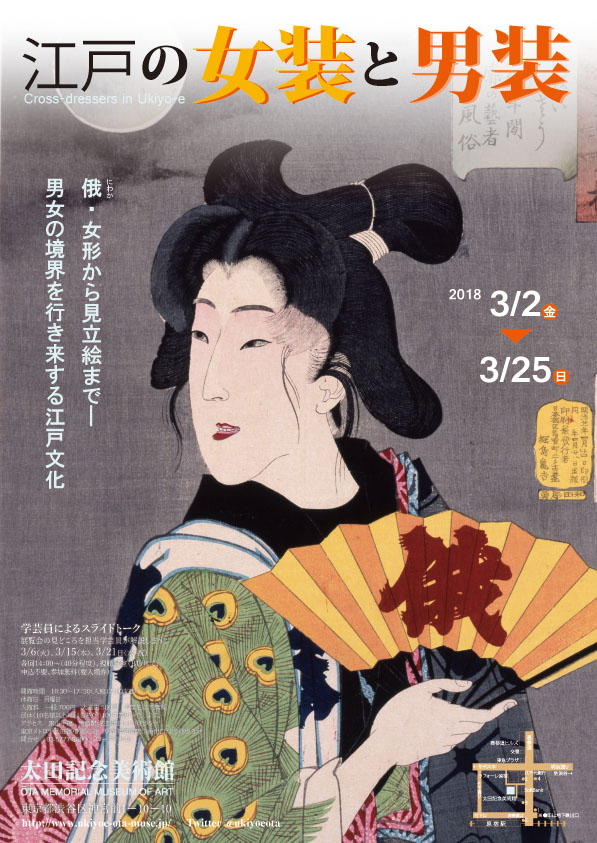
Edo culture on the boundary line between men and women
The culture of cross-dressing is seen throughout history, across different countries from the East to the West. In Japan, the story of Yamato Takeru dressing as a woman to conquer the enemy from Kojiki (Records of Ancient Matters) is famous. Such customs have been prevalent for a long time, as we can see in the example of Chigo (child of festivity) in the Middle Ages and entertainment performers. They are also seen in the Edo period, such as geisha in men’s clothes performing at festivals and male kabuki actors specializing in playing female roles. Benten the Thief, a cross-dresser thief in kabuki shows how cross-dressing characters on stage have been widely known to the public.
In ukiyo-e pictures, artists often switched the genders of historical and fictional characters, and drew them as fashionable persons in “parody pictures.”
The idea of switching male and female, reminds us of the recent hit movie “Your Name”. However, history tells us that people were familiar with the concept of cross-dressing and switching genders since the Edo period. Through ukiyo-e pictures, this exhibition will present the various customs and cultures in the Edo period which flow freely beyond boundaries of male and female.
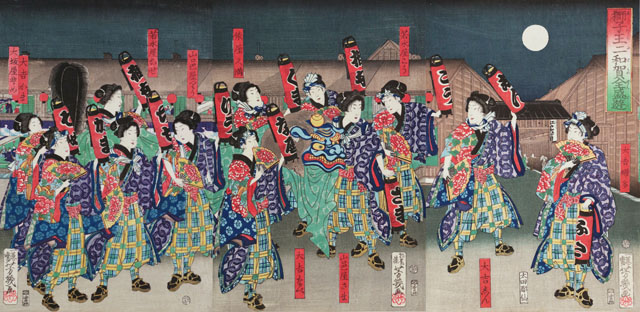
Ochiai Yoshiiku “Niwaka Festival at Shin-Yoshiwara”
Cross-dressed women at festivals
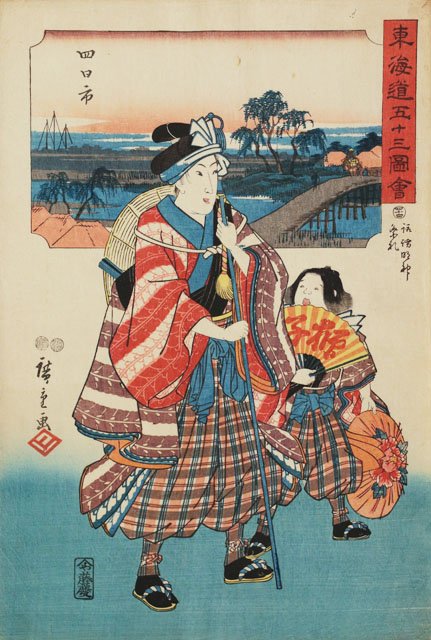
Utagawa Hiroshige “Fifty-three Stations of the Tōkaidō Road : 44, Suwa Myōjin Shrine Festival at Yokkaichi”
In Yoshiwara, the pleasure quarter in the Edo period, a festival called Niwaka was held in August. Geishas dressed in men’s clothes performed lion dances and impromptu skits on the main street, Nakano-chō . They brought excitement to the festival by dressing up as black kites or performing a famous play called Sukeroku. These customs were seen in festivals in various places, including Sannō Festival and Kanda Festival.
Cross-dressing in stories
In Japan, there are ancient stories of cross-dressing, including that from Kojiki (Records of Ancient Matters) of Yamato Takeru dressed as a woman to conquer the enemy, and that of Ushiwakamaru fighting against Benkei as a cross-dressing boy. In the Edo period, Benten, the thief from a kabuki play who crossed-dressed as a woman, and Inusaka Keno, the swordsman dressed as a woman from “Nansō Satomi Hakkenden” (The Story of Eight Samurai), grew in popularity. In this section, we introduce cross-dressers who appear in stories.
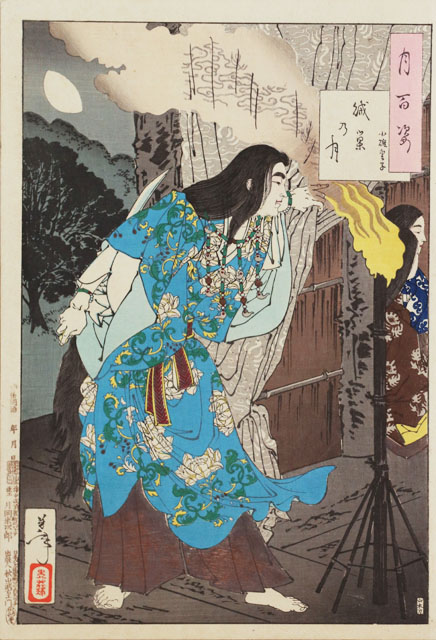
Tsukioka Yoshitoshi “One Hundred Views of the Moon : Moon of the Enemy’s Lair, Prince Ousu”
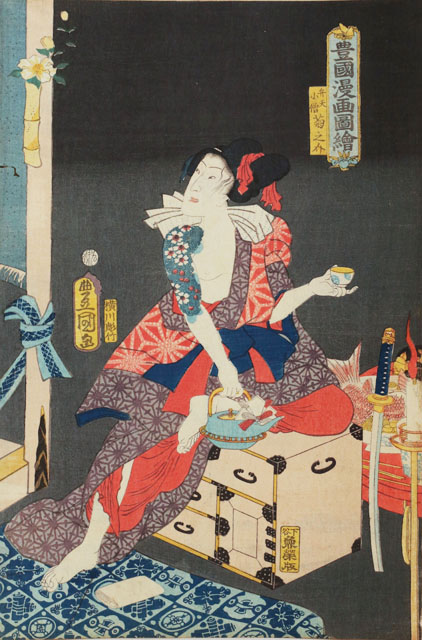
Utagawa Kunisada (Toyokuni Ⅲ) “Illustrations by Toyokuni : Benten Kozō Kikunosuke”
Specialist of the cross-dressing – Kabuki female impersonators
It seems to have been that in the troupe of Izumo-no Okuni, which founded kabuki, women including Okuni, cross-dressed to play male characters, and men cross-dressed to play female characters. After women were prohibited from playing kabuki in 1629, some male actors specialized in playing female roles and many great cross-dressing actors appeared in kabuki scenes. The actors of female roles were encouraged to live their daily lives as women as well. They were the specialists of cross-dressing.
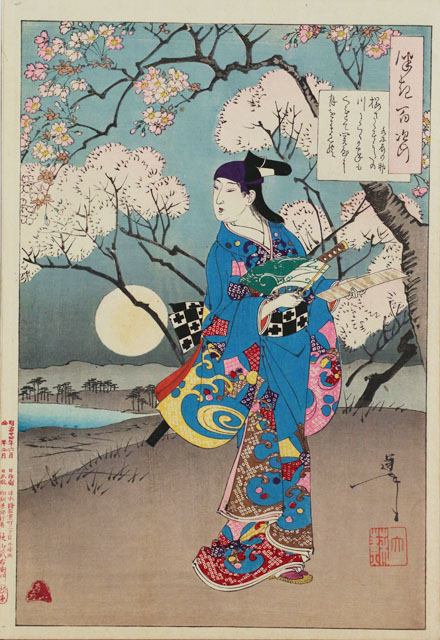
Tsukioka Yoshitoshi “One Hundred Views of the Moon : Mizuki Tatsunosuke Ⅰ”
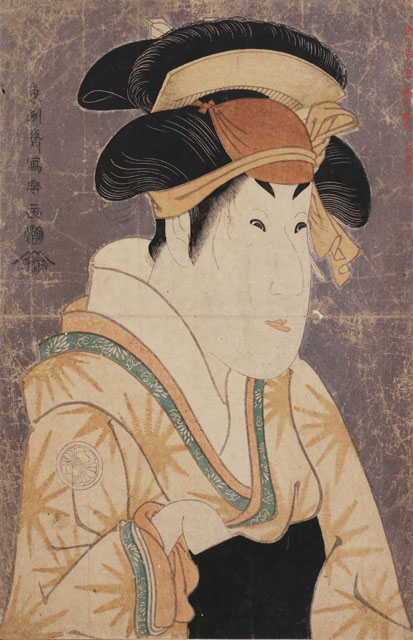
Tōshūsai Sharaku “Kabuki Actor Segawa Kikunojō Ⅲas Oshizu, a Wife of Tanabe Bunzō”
Switching Genders in Kabuki play and ukiyo-e pictures
In kabuki plays such as “Onna-sukeroku” and “Onna-seigen”, there is a custom of switching male characters to female characters. Also, many “parody pictures” in ukiyo-e switch the genders of historical and fictional characters and draw them as fashionable persons. In this section we introduce the stylish cross-dressing that common people enjoyed during the Edo period.
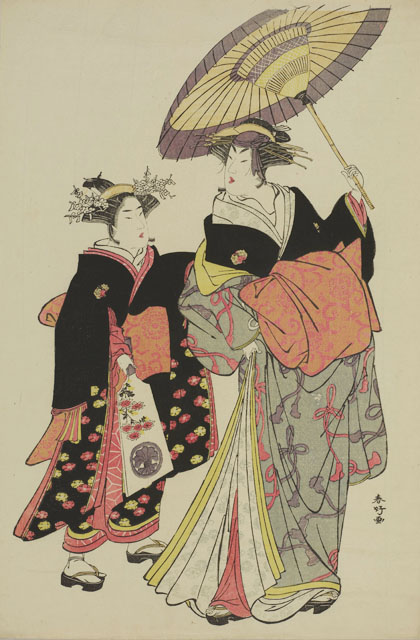
Katsukawa Shunkō “Kabuki Actor Segawa Kikunojō Ⅲas Onna –sukeroku”
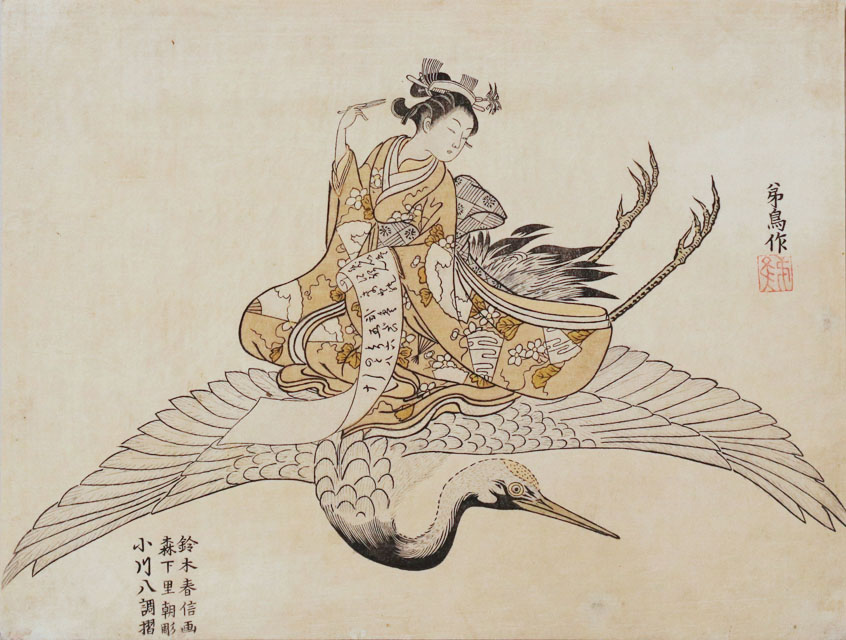
Suzuki Harunobu “Parody of a Legendary Wizard Hichōbō”
Highlight of the exhibition
Tsukioka Yoshitoshi “Thirty-Two Aspects of Women: Looking Suitable, Mannerisms of a Geisha of the Kōka Period”
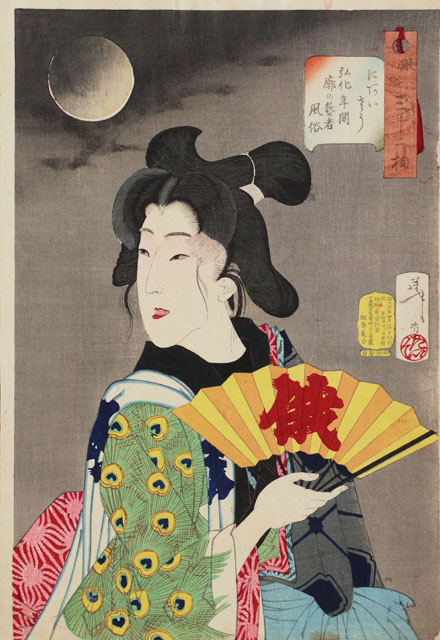
“Thirty-two Aspects of Women” is a set of 32 pictures of beautiful women that Tsukioka Yoshitoshi produced in his later years. They are based on themes such as “looking cold” or “looking painful”, of women of various ages and occupations. This particular picture expresses “looking suitable”. What makes it “looking suitable”?
According to the explanation in this picture, the person depicted was a geisha at the brothel from 1844 to 1848. The female geisha who participated the festival in Yoshiwara called Niwaka in August, is dressed up as a black kite called Tekomai. She is drawn as wearing men’s clothes with a men’s hairstyle, holding a fan marked “Niwaka”. Since this cross-dressed female geisha is looking well and dignified, it must be the reason why this picture is titled “looking suitable”.
Admission
| Adult | 700 yen |
|---|---|
| University and High school students | 500 yen |
| Junior High School Students and below | Free |
Calendar
Closed
-
- 2018 March
SUN MON TUE WED THU FRI SAT 1 2 3 4 5 6 7 8 9 10 11 12 13 14 15 16 17 18 19 20 21 22 23 24 25 26 27 28 29 30 31
- 2018 March
Ukiyo-e from the end of the Edo Period to the Meiji Period
[2nd Term] February 2nd-25th
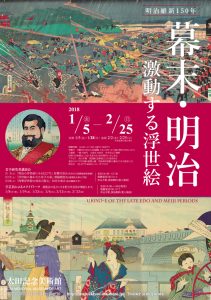
150 years ago, Japan experienced historical changes, from the downfall of the Edo shogunate to the establishment of the Meiji Government. Ukiyo-e artists who were active from the end of the Edo Period to the early Meiji Period portrayed social changes such as the Boshin War and westernization, and explored new forms of art by accepting Western styles. 2018 is the 150th year from the Meiji Restoration. In its commemoration, we introduce 150 pieces of ukiyo-e produced from the end of the Edo Period to the Meiji Period (the exhibits will be changed between the first term and the second term). Please enjoy the rapidly changing ukiyo-e, mirroring the turbulence from the end of the Edo Period into the Meiji Period.
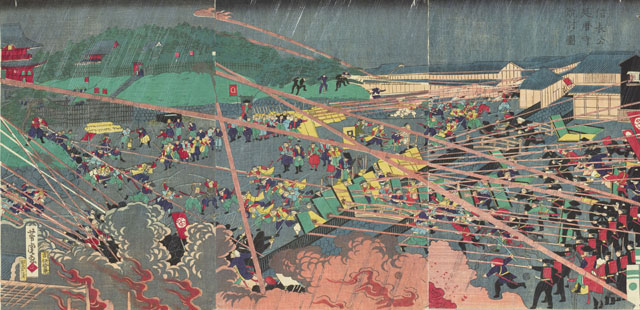
Utagawa Yoshitora “Caricature of the Ueno War : Fire Attack of the Enryaku-ji Temple” (1st term)
Highlight ① 2018 is the 150th year from the Meiji Restoration. Let’s reflect upon this turbulent period.
The Boshin War started in 1868, ending in the collapse of the Edo shogunate. Edo changed its name to Tokyo, and modernized rapidly. Through the caricatures depicting the turmoil of the end of the Edo period and pictures portraying the modernized landscapes of Tokyo, we will reflect upon this dynamic period.
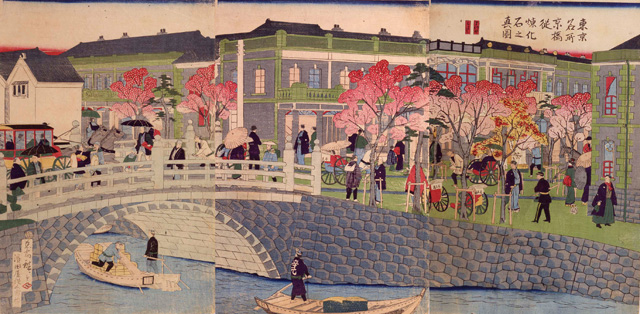
Utagawa Hiroshige Ⅲ ”Scenery of Brick Masonry Building at Kyōbashi in Tokyo” (2nd term)
Highlight ② Saigō Takamori as depicted by ukiyo-e artists
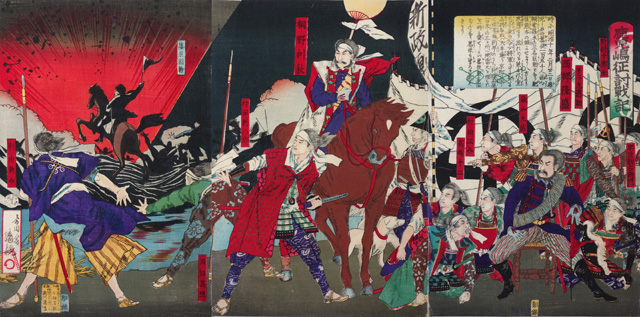
Kobayashi Kiyochika “Troop of Saigō Takamori Attacking Kumamoto Castle”(1st term)
Highlight③ Tsukioka Yoshitoshi and Kobayashi Kiyochika. Ukiyo-e artists who gathered attention in this period.
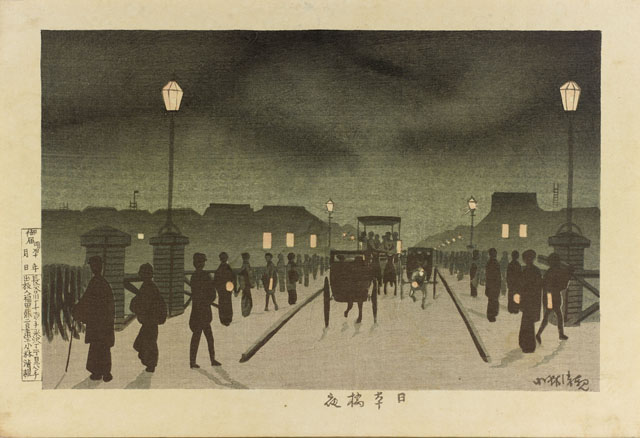
Kobayashi Kiyochika “Night Sight at Nihonbashi”(2nd term)
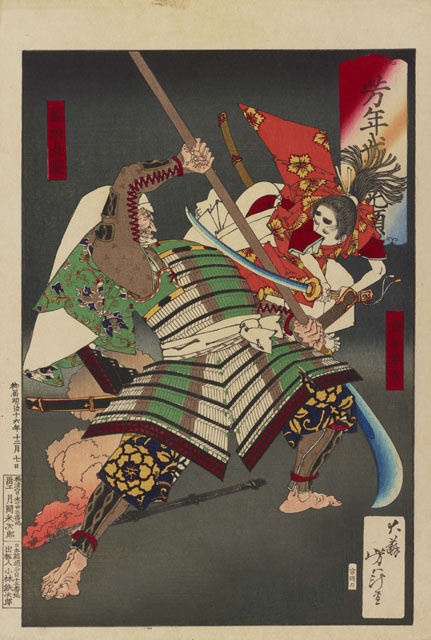
Tsukioka Yoshitoshi “Yoshitoshi’s Courageous Warriors : Minamoto-no Ushiwakamaru Battling with Kumasaka Chōhan”
(1st term)
<Highlight work of Exhibition>
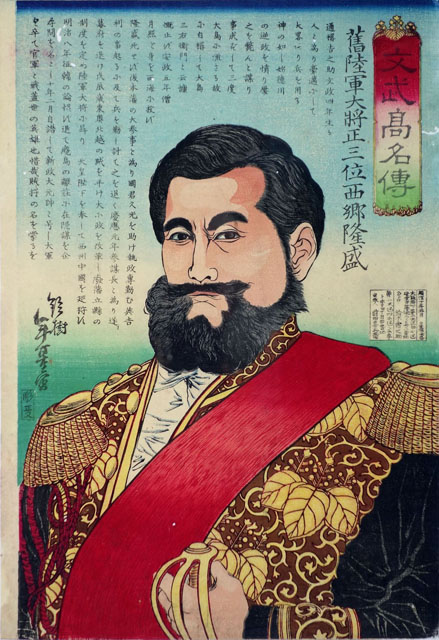
Suzuki Toshimoto “Famous People for Both Literary and Military Arts : Saigō Takamori” (1st term)
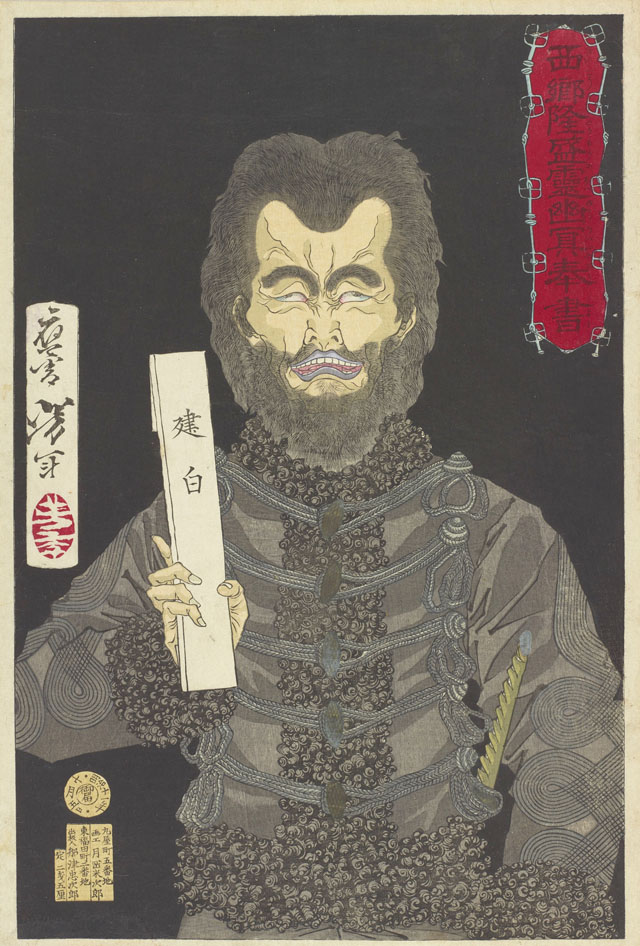
Tsukioka Yoshitoshi “Ghost of Saigō Takamori Holding a Petition” (2nd term)
Admission
| Adult | 700 yen |
|---|---|
| University and High school students | 500 yen |
| Junior High School Students and below | Free |
Calendar
Closed
-
-
2018 January
SUN MON TUE WED THU FRI SAT 1 2 3 4 5 6 7 8 9 10 11 12 13 14 15 16 17 18 19 20 21 22 23 24 25 26 27 28 29 30 31
-
-
2018 February
SUN MON TUE WED THU FRI SAT 1 2 3 4 5 6 7 8 9 10 11 12 13 14 15 16 17 18 19 20 21 22 23 24 25 26 27 28
Kikukawa Eizan
[2nd Term] December 1st-20th
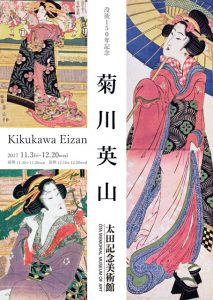

Woman with an Umbrella [1st Term]
Kikukawa Eizan (1787-1867) was an ukiyo-e artist playing an active part especially in the Bunka era (1804-1818) after the death of Kitagawa Utamaro. While many ukiyo-e artists portrayed beautiful women in the sophisticated and ethereal Utamaro style, Eizan ushered in a new phase in the bijinga genre; although his women too wear the latest fashionable kimonos, he established his own sweet down-to-earth vision of female beauty. His works portrayed a diverse range of women from different social classes, such as the graceful young ladies of samurai families, charming daughters of merchants, or flamboyant courtesans. We see them sleek, svelte, and elegant, or sometimes bright, colorful, and fashionable. In recent years, Eizan’s bijinga are not well-known, but these works would have profoundly influenced not only his pupil Keisai Eisen, but also such later artists as Utagawa Kunisada and Utagawa Kuniyoshi. It is no exaggeration to say that bijinga in the 19th century started from Eizan.
This year commemorates the 150th year since the death of Kikukawa Eizan. This exhibition is made up of some 200 outstanding works, covering wood-block prints and nikuhitsu-ga (original paintings), including important representative pieces and works shown to the public for the first time; together they once again shine the spotlight on Kikukawa Eizan’s achievements as an ukiyo-e artist. We would be grateful if, through this exhibition, you can fully enjoy the fascination of Eizan’s beauties that blossomed so gracefully in response to the culture of the late Edo period.
Finally, we would like to sincerely express our gratitude to all those collectors who loaned their valuable works and materials to the exhibition, and all those involved in the mammoth task of assembling this wonderful display of the artist’s works.
The blossoming of Eizan’s beauties
It was in his late teens that Kikukawa Eizan made his debut into the world of ukiyo-e with his animated bijinga (ukiyo-e prints of beautiful women). Working first in the style of Kitagawa Utamaro he became a popular ukiyo-e artist at a young age, and after Utamaro’s death, Eizan, in his mid-twenties, began exploring a new style of bijinga, finally reaching an image of charming, slender, and elegantly-proportioned women with beguiling large dark eyes. Utamaro’s beauties are tall and slim and living in a world free of cares; they are the super models of their times. While the sweet charming and smaller beauties of Eizan are approachable with an everyday feel about them akin to the photos of reader models appearing in today’s fashion magazines. Eizan’s women and their new fresh beauty were much loved by people in the city of Edo.

Comparison of the Flowery Courtesans of Yoshiwara : Chōzan and Nishikido of the Chōji-ya House[1st Term]
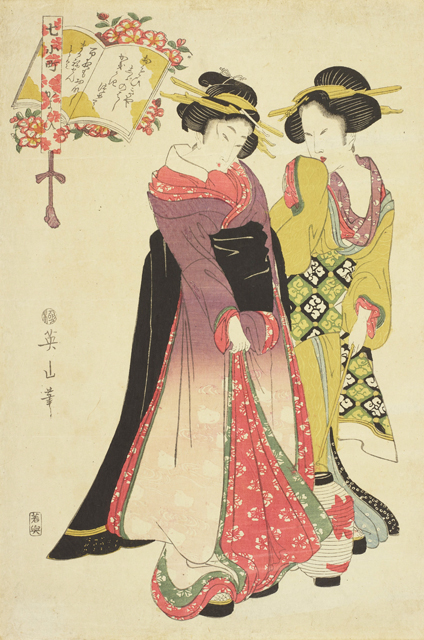
Seven Beauties Based on the Stories of Ono-no Komachi : Geisha Going to a Banquet [2nd Term]
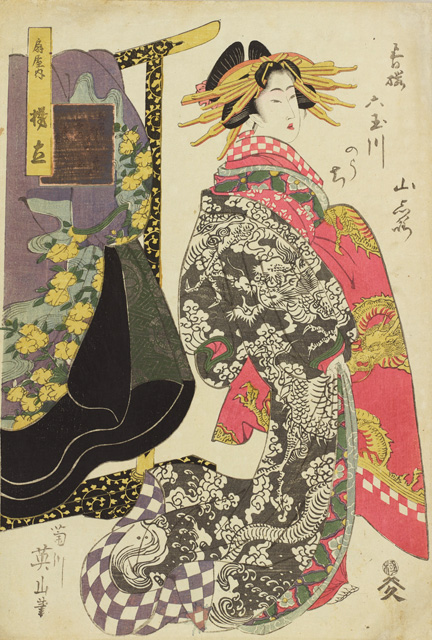
Six Views of theTama River and Beauties in Pleasure Quarters : Yamashiro Province, Courtesan Hashitate of the Ōgi-ya House [2nd Term]
Eizan’s beauties were models of women’s fashion
In Eizan’s works, women who lent color and charm to the streets of Edo constantly appear: pretty girls attracting customers to the many teahouses, mothers and daughters strolling, geishas or courtesans entertaining. All of his works give us an exciting glimpse into this attractive world of high fashion, stylish kimono, and beautiful accessories. And yet, in those days, according to a woman’s social class or age there were restrictions and rules concerning hairstyles, makeup, and even prescribing the manner of wearing kimono; against such a backdrop how to enjoy and exploit the latest fashion was a great concern for women in Edo. Eizan’s beauties proclaimed the latest trends of this fashion-conscious society and were a visual guide of the rules applied to such themes as the seasonal motifs spread by popular actors, or sasairo-beni (iridescent lip rouge), which would have excited the hearts of women in just the same way as our present-day glossy fashion magazines.
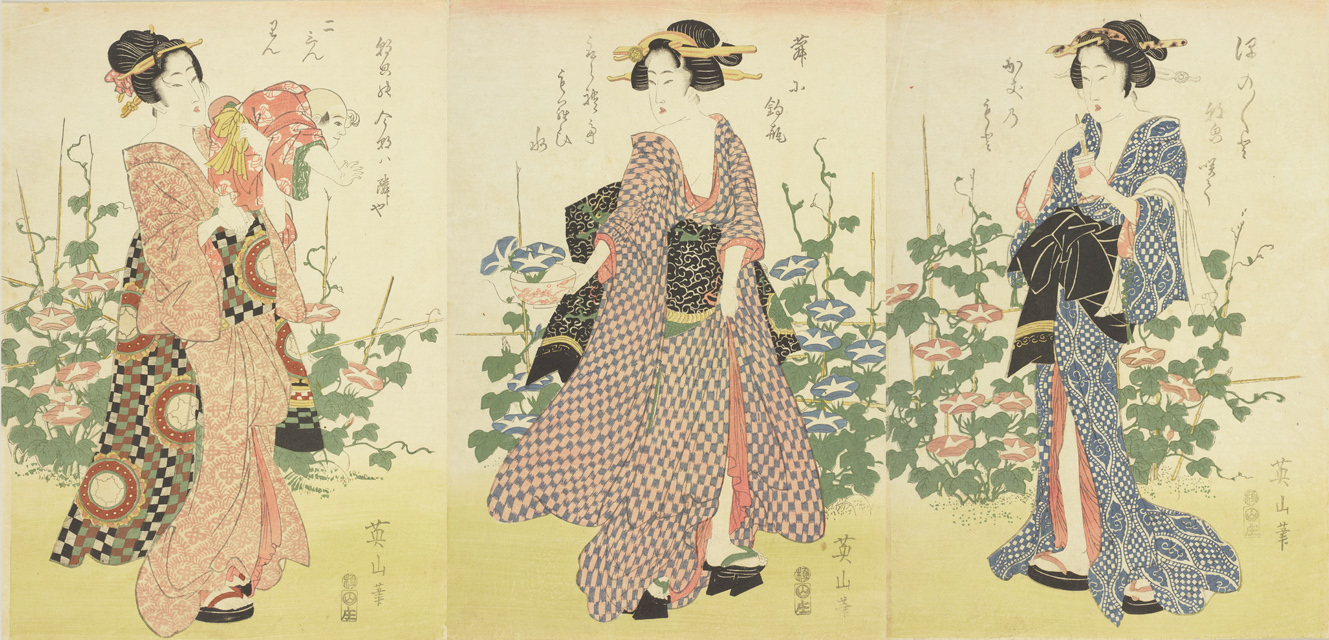
Morning Glories and Three Beauties [2nd Term]

Lantern Festival at Yoshiwara in Autumn [2nd Term]
Shining the spotlight on a neglected period in bijinga
In any discussion of ukiyo-e bijinga, the Bunka era (1804-1818), when Eizan was at his most energetic, does not normally draw much attention. In recent years, however, exhibitions of Keisai Eisen, his pupil, and Utagawa Kuniyoshi, and Utagawa Kunisada have been held, and those ukiyo-e artists who flourished around the end of the Edo period, are now gaining in popularity. This exhibition, displaying Eizan’s works in chronological order, reconsiders the significance of his bijinga, and how they connected the grand master Kitagawa Utamaro to those artists in the closing days of the Tokugawa Shogunate.
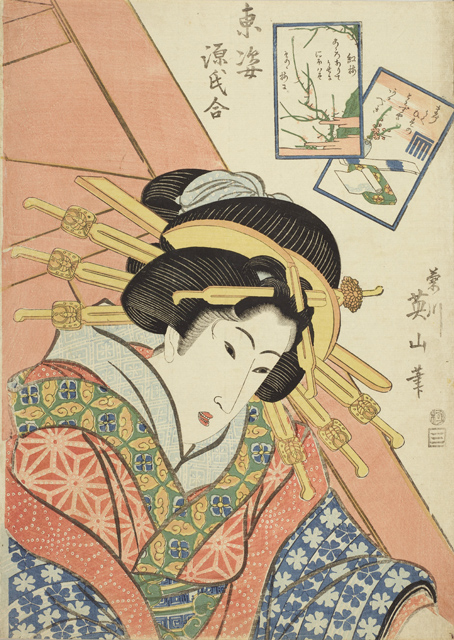
Women of Edo with the Cards of the Tale of Genji : Red Plum Blossom [1st Term]
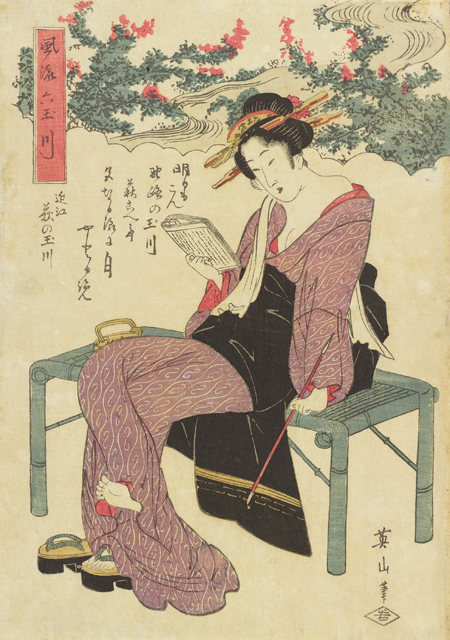
Six Views of theTama River : Ōmi Province, Bush Clovers around the Tama River [1st Term]
An array of the finest works, including some on public display for the first time, and others from the outstanding Japan Ukiyo-e Museum Collection
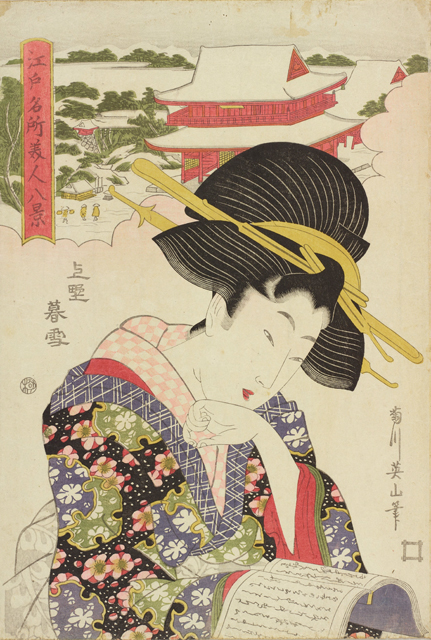
Eight Famous Places and Beauties of Edo : Evening Snow at Ueno [1st Term]

Six Views of theTama River : Ōmi Province, Bush Clovers around the Tama River [1st Term]
<Highlight work of Exhibition>
Six Views of theTama River [1st Term]
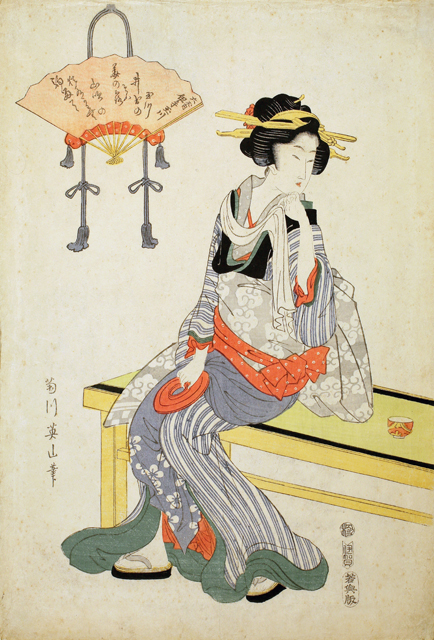
This well-preserved picture from the Japan Ukiyo-e Museum Collection is a superb work and the pale blue color, which usually would have faded over time, is still clearly distinct. A woman sitting on a bench in a tea stall is lost in thought; in those days tea stalls were commonly set up in any busy place, such as a temple or shrine, and good-looking women often worked in such places. At first sight the woman appears modestly dressed in a bluish purple striped kimono, with a floral pattern apron and a grey cloud pattern obi sash, but her apron strap and other items colored in vermillion provide very effective high-lights; her fingertips holding a hand towel draped from her shoulder are depicted very softly, suggesting a gentle and alluring feminine presence. This print crystalizes an idealized image of woman.
Translation Supervised by Japanese Students Association of Princeton University
Admission
| Adult | 1000 yen |
|---|---|
| University and High school students | 700 yen |
| Junior High School Students and below | Free |
開館日カレンダー
休館日
-
2017 NovemberSpecial Exhibition
SUN MON TUE WED THU FRI SAT 1 2 3 4 5 6 7 8 9 10 11 12 13 14 15 16 17 18 19 20 21 22 23 24 25 26 27 28 29 30 -
2017 DecemberSpecial Exhibition
SUN MON TUE WED THU FRI SAT 1 2 3 4 5 6 7 8 9 10 11 12 13 14 15 16 17 18 19 20 21 22 23 24 25 26 27 28 29 30 31
Katsushika Hokusai “Thirty-six Views of Mt. Fuji”
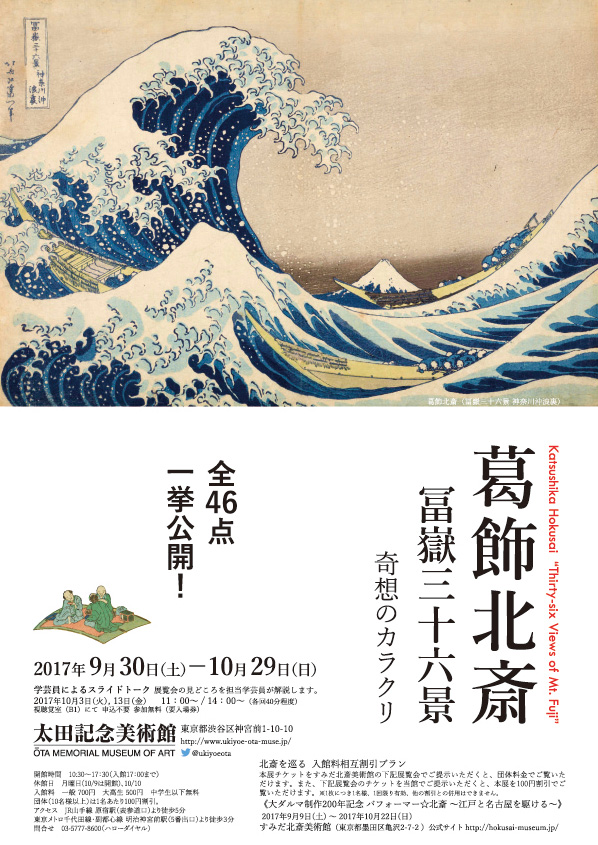
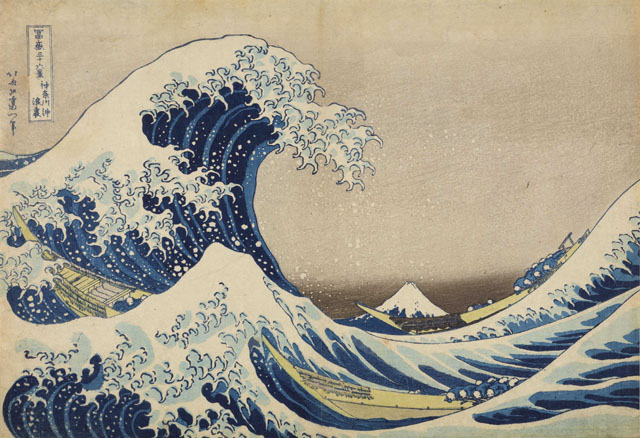
Katsushika Hokusai “Thirty-six Views of Mt. Fuji: Great Wave off the Coast of Kanagawa”
Exhibition of the complete 46 works of Hokusai‘s “Thirty-six Views of Mt. Fuji”
“Thirty-six Views of Mt. Fuji” is a series of landscape prints, depicting Mt. Fuji from various locations in Japan. Despite the number “36” in the title, the series actually consists of “46” works, since 10 more works were added later due to the successful sales and popular demand. The complete 46 works, owned by Ōta Memorial Museum of Art, will be exhibited for the first time in the 7 years since 2010. We hope you will enjoy the greatest masterpieces by Hokusai.
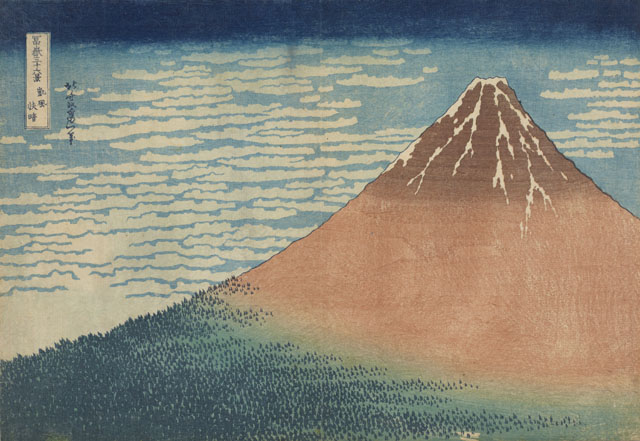
Katsushika Hokusai “Thirty-six Views of Mt. Fuji: Mild Breeze on a Fine Day”
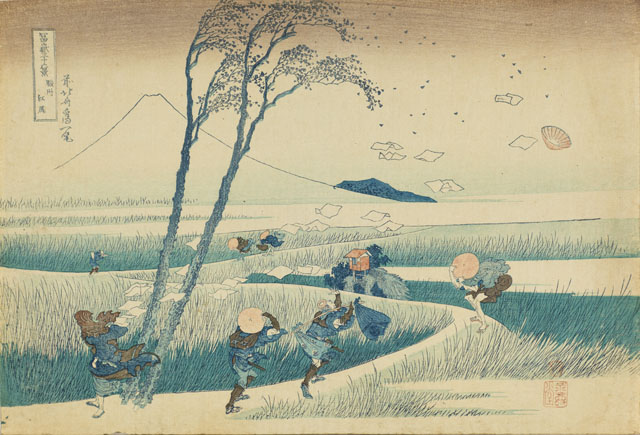
Katsushika Hokusai “Thirty-six Views of Mt. Fuji: Ejiri in Suruga Province”
Deciphering the innovative ideas hidden in “Thirty-six Views of Mt. Fuji“
The series is full of unconventional, original and striking ideas, as seen in “Mild Breeze on a Fine Day” and “Great Wave off the Coast of Kanagawa” as fine examples. It is perhaps Hokusai‘s new enlightenment that he had achieved when he passed 70, after his persistent devotion to ukiyo-e as an artist. In this exhibition, we will try to decipher Hokusai‘s innovative ideas hidden in “Thirty-six Views of Mt. Fuji“.
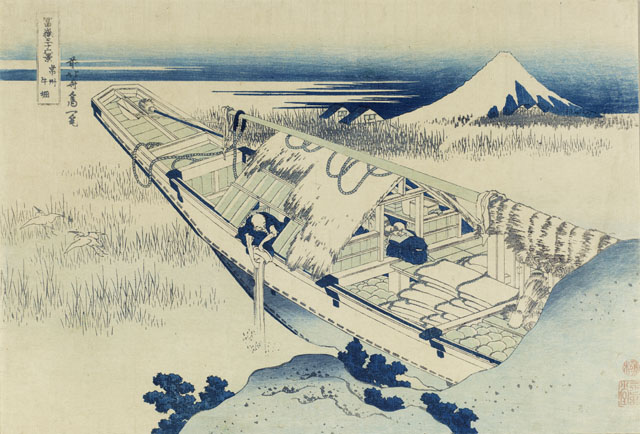
Katsushika Hokusai “Thirty-six Views of Mt. Fuji: Ushibori in Hitachi Province”
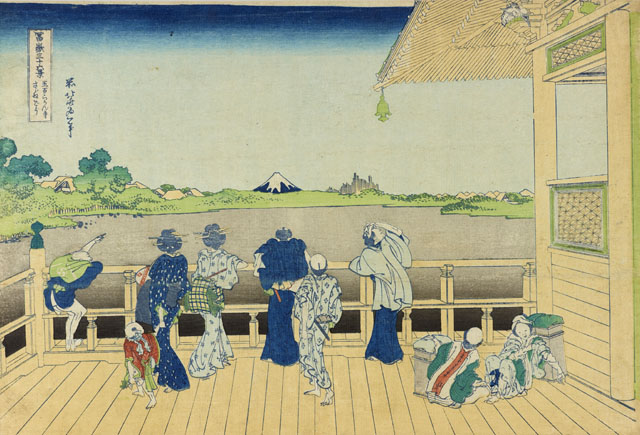
Katsushika Hokusai “Thirty-six Views of Mt. Fuji: View from Sazai-dō Hall of the Gohyaku Rakan-ji Temple”
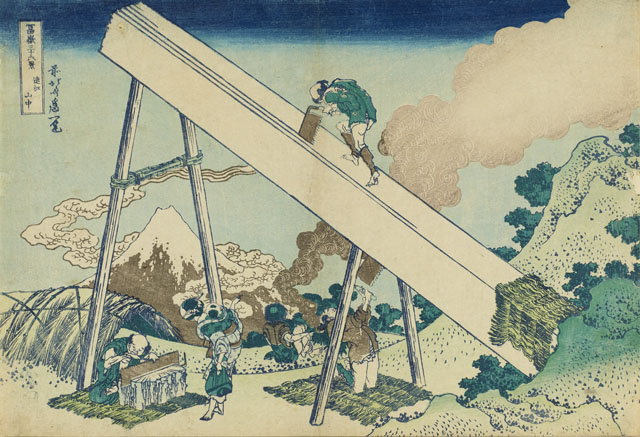
Katsushika Hokusai “Thirty-six Views of Mount Fuji: In the Mountains of Tōtoumi Province”
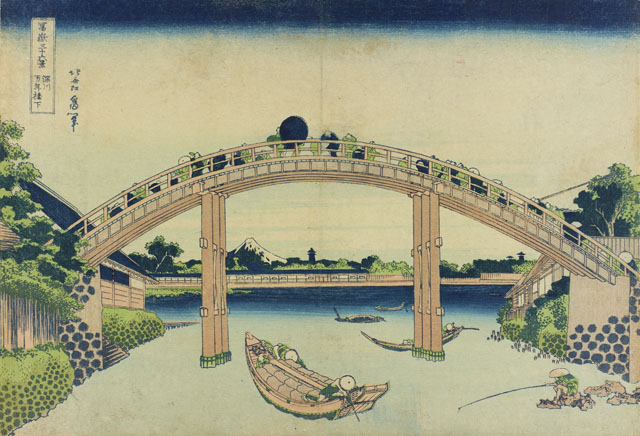
Katsushika Hokusai “Thirty-six Views of Mt. Fuji: Under Mannen-bashi Bridge at Fukagawa”
Special exhibition of “Courtesans Showing Themselves to the Strollers through the Grille ” by Hokusai‘s daughter Ōi
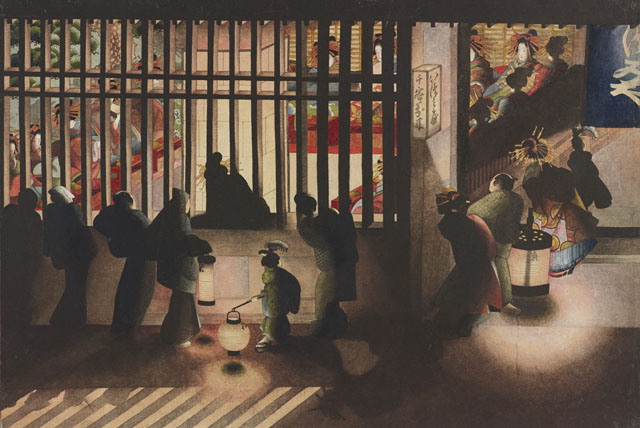
Katsushika Ōi “Courtesans Showing Themselves to the Strollers through the Grille”
*A TV drama based on the historical novel by Makate Asai,, a winner of the Naoki Prize (a literary award), will be broadcast on NHK on 18th September, starring Aoi Miyazaki, with a screenplay by Mika Ōmori.
<Highlight work of Exhibition>
Katsushika Hokusai “Thirty-six Views of Mt. Fuji:: Shower below the Summit”
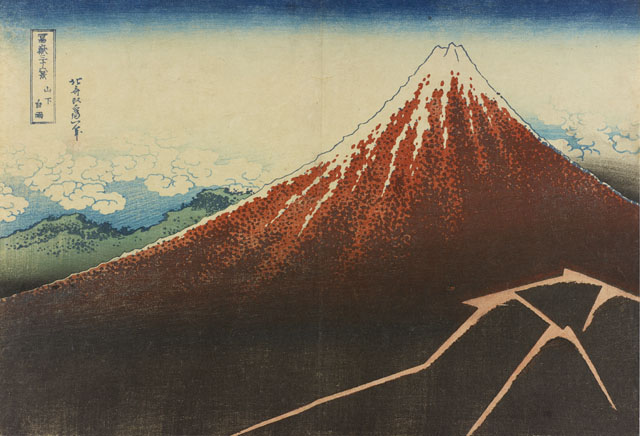
Although the sky above Mt. Fuji is clear and blue, the bottom of the mountain is covered with black, dark cloud. The diagonal lines depicted at the bottom right corner represent the stylized lightening. The picture is a simply expressed depiction of the mountain’s foot being hit by a sudden, heavy thunder storm. It is an outstanding work of Hokusai, with his innovative idea: the two totally different weather events – fine weather and rain – are effortlessly represented in one painting.
Admission
| Adult | 700 yen |
|---|---|
| University and High school students | 500 yen |
| Junior High School Students and below | Free |
Calendar
Closed
-
2017年10月
SUN MON TUE WED THU FRI SAT 1 2 3 4 5 6 7 8 9 10 11 12 13 14 15 16 17 18 19 20 21 22 23 24 25 26 27 28 29 30 31
Tsukioka Yoshitoshi “One Hundred Views of the Moon”

Exhibition of the complete 100 works of “One Hundred Views of the Moon”: Tsukioka Yoshitoshi’s most well-known works from his last year
Following our previous exhibition “Specters by Tsukioka Yoshitoshi” (July 29 ~ August 27, 2017), we would like to further explore in depth the fascinating world of Tsukioka Yoshitoshi, an ukiyo-e artist who lived from the end of the Edo period to the Meiji period. In this exhibition, we will present “One Hundred Views of the Moon” series, which are Yoshioshi’s masterpieces from his last year. As the title describes, “One Hundred Views of the Moon” consists of a total of 100 pictures. This exhibition provides a very rare opportunity to see all the pictures in one place. It is also an unmissable opportunity to see the ultimate achievement of Yoshitoshi, who is renowned as the last ukiyo-e master.
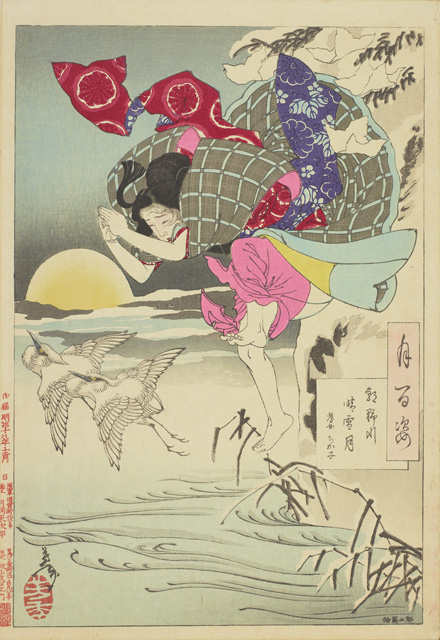
“Moon of Pure Snow at the Asano River : Chikako, the Filial Daughter
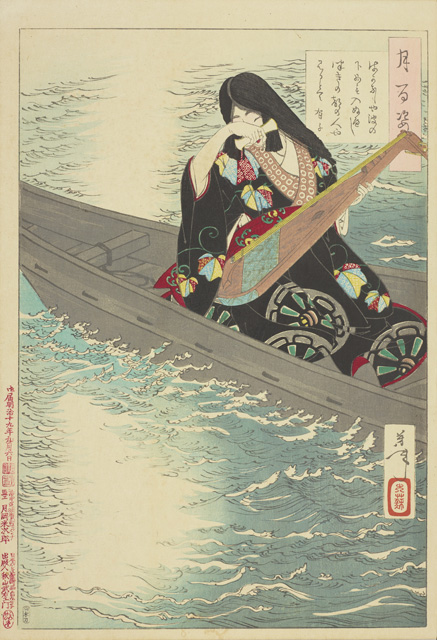
‘”How hopeless it is, it would be better for me to sink beneath the waves perhaps then I could see my man from moon capital” -Poem by Ariko
Appreciating “One Hundred Views of the Moon” from four different aspects
The themes of “One Hundred Views of the Moon” are based on stories related to the moon. They vary widely, from warriors and beautiful women in the Heian period and the Age of Civil Wars, to mystic creatures such as ghosts and monsters. In this exhibition, we will aim to present a clearer view of the world of “One Hundred Views of the Moon” by categorizing them based on four different aspects: 1) beautiful women; 2) specters, ghosts, deities and Buddha; 3) brave men; and 4) refinement, nostalgia and sorrow. We hope you will enjoy a variety of stories surrounding the moon, which are appropriate for the autumn, the season of beautiful moon.
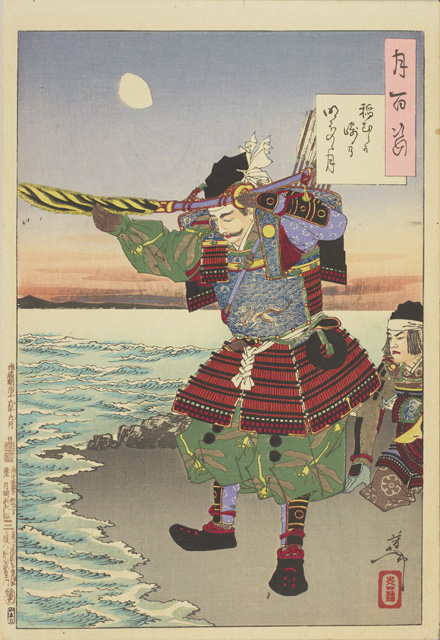
“Moon over Cape Inamura at Daybreak”
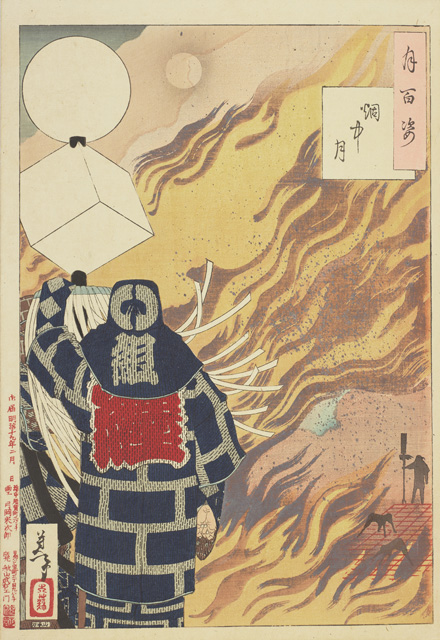
“Moon through Conflagration”
Innovative compositions and vivid colors are still fresh even after more than 100 years
Even though the “One Hundred Views of the Moon” series were created between 1885 and 1892, more than 130 years ago, they are still full of freshness and charm. The powerful compositions cropped out from a dynamic viewpoint, the sense of serenity that fills the air with silence on a moonlight night, and
the sophisticated carving skills and the beauty of prints presented in these works make the viewers say “Cool!” or “Beautiful!” even in modern days. The “newness” of “One Hundred Views of the Moon” is highlighted in this exhibition.
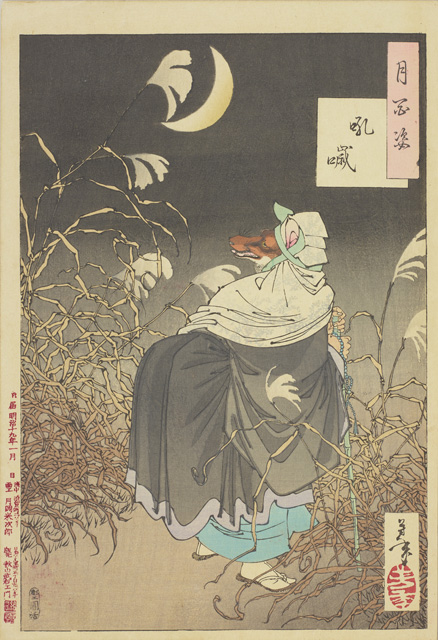
“Cry of the Fox”
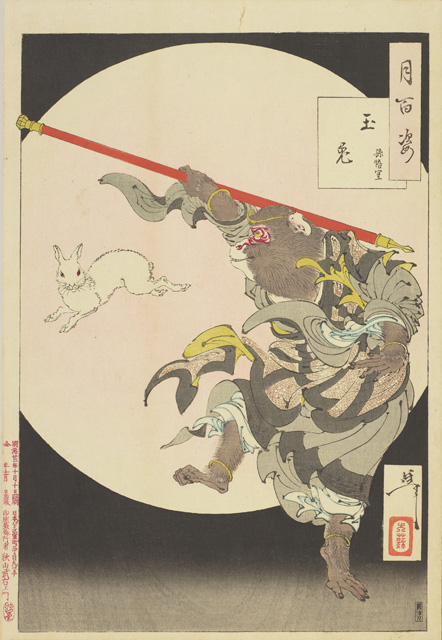
“Jade Rabbit and Sun Wukong”
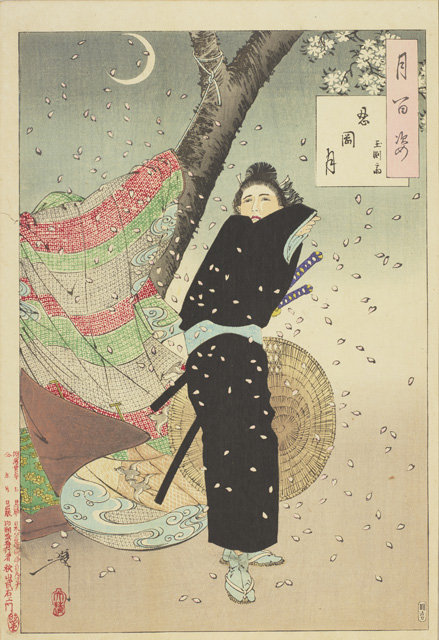
“Moon at Shinobugaoka : Gyokuensai”
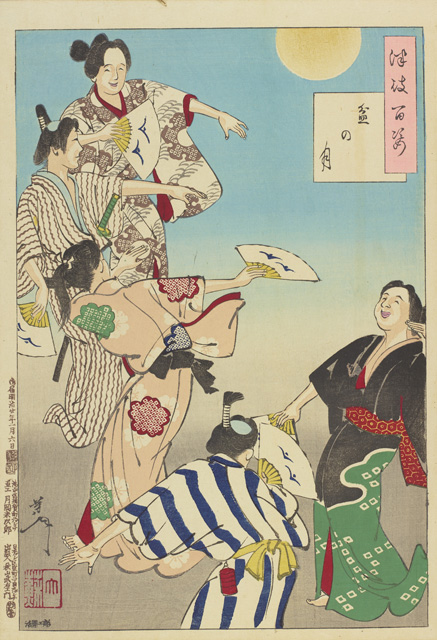
“Moon above the Bon Festival”
<Highlight work of Exhibition>
“Moon Above the Daimotsu Bay : Benkei”
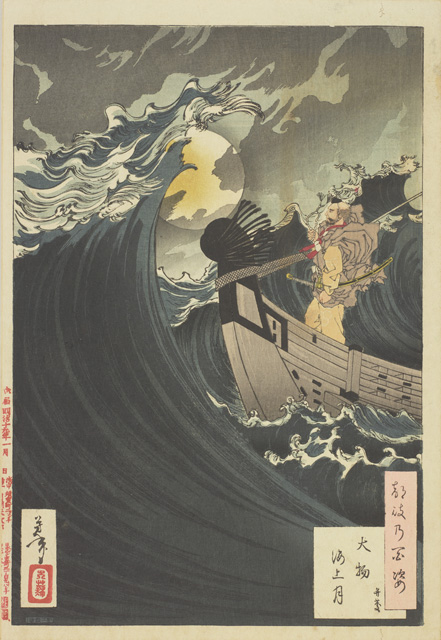
When Minamoto no Yoshitsune and his retainers embarked from Daimotsu Bay, suddenly a storm came and vengeful ghosts of Heike warriors, who were defeated and sank into Dan-no-ura Bay, tried to prevent Yoshitsune’s voyage. One of his retainers Benkei, however, impressively warded off the ghosts by chanting Buddhist prayers. Although the vengeful ghosts of Heike warriors are not clearly depicted in this work, the pitch-dark ocean that occupies a large part of the picture and the ominous movements of the waves that are crashing over Benkei give uneasy feelings to the viewers. This meticulously calculated, powerful picture represents typical characteristics of Yoshitoshi’s works.
Admission
| Adult | 1000 yen |
|---|---|
| University and High school students | 700 yen |
| Junior High School Students and below | Free |
Calendar
Closed
-
-
-
-
2017 SeptemberSpecial Exhibition
SUN MON TUE WED THU FRI SAT 1 2 3 4 5 6 7 8 9 10 11 12 13 14 15 16 17 18 19 20 21 22 23 24 25 26 27 28 29 30
-
-
-
Specters by Tsukioka Yoshitoshi
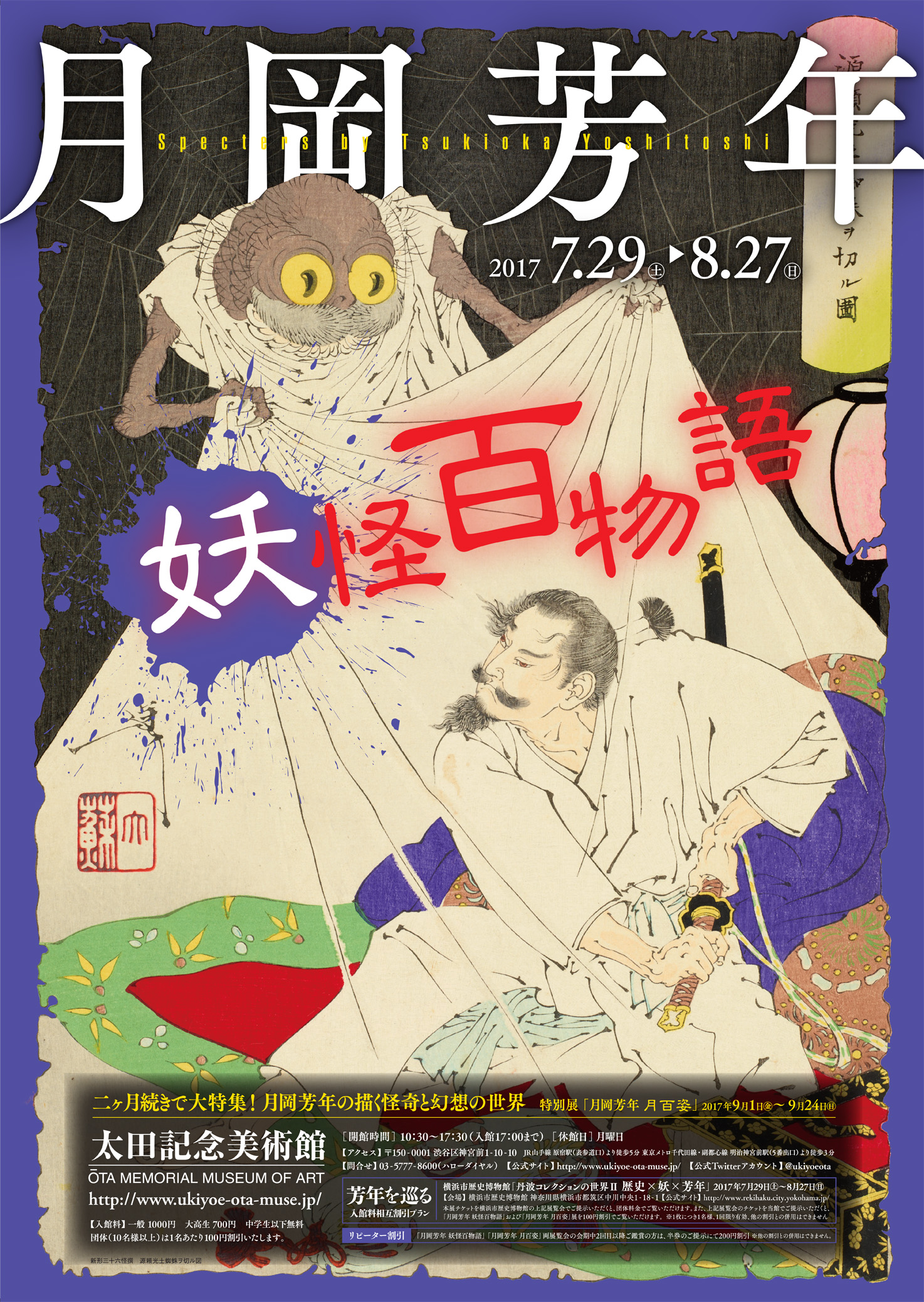
Introduction
Tsukioka Yoshitoshi (1839~1892) was an ukiyo-e artist who lived from the end of the Edo period to the Meiji period, and was a pupil of Utagawa Kuniyoshi. He was one of the leading and the most popular ukiyo-e artists in the Meiji period. Yoshitoshi produced a wide range of pictures, such as “warrior pictures”, “historical pictures” and “pictures of beautiful women”; however, what he focused on most throughout his life were “pictures of Yōkai (specters)” which took themes from mystic stories of history, legends, novels and plays. There is an anecdote that Yoshitoshi often saw ghosts, and he was also good at telling scary stories. It is said that he sometimes participated as a storyteller in “One Hundred Ghost Stories” gatherings (an event at which people gather to recount and listen to one hundred mysterious stories.) Among the large number of Yoshitoshi’s works, a set of pictures “One Hundred Ghost Stories of China and Japan”, which consists of 26 pictures produced in the early stage of his career as an artis, and a set of pictures “New Forms of Thirty-six Ghosts”, which consists of 36 pictures produced in his last years, are known as the masterpieces of “picture books of specters” in which a lot of specters and mysterious creatures appear. In this exhibition, we will exhibit the complete works of both “One Hundred Ghost Stories of China and Japan” and “New Forms of Thirty-six Ghosts”, as well as about 100 pictures from his early years to his later years, introducing Yoshitoshi’s world of “pictures of specters”.
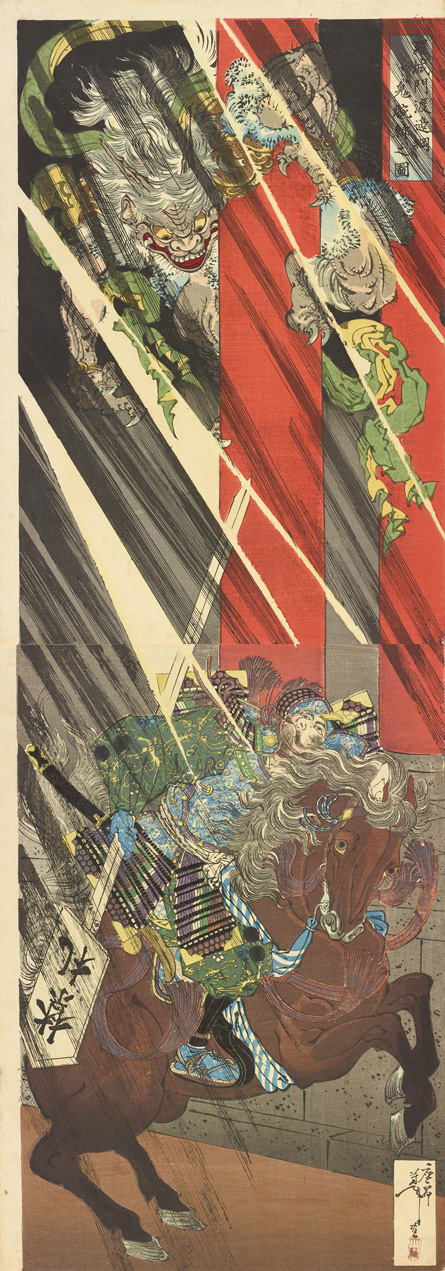
“Ogre at the Rashōmon Gate Attacking Watanabe-no Tsuna
Exhibiting about 100 “pictures of specters” by Tsukioka Yoshitoshi
Tsukioka Yoshitoshi showed his interest in mysterious subjects for his paintings from his early days as an artist, and continued drawing specters throughout his career. It is considered that Yoshitoshi was influenced by his master Utagawa Kuniyoshi, who excelled in painting specters. It is also said that Yoshitoshi himself had a feeling of closeness to mystic creatures, and the story of him often seeing ghosts has been passed down. There is an anecdote that he was good at telling scary stories and he used to read out “One Hundred Ghost Stories” to his adopted daughter. In this exhibition, we will introduce the fascinating specters drawn by Yoshitoshi, which are terrifying but sometimes humorous.
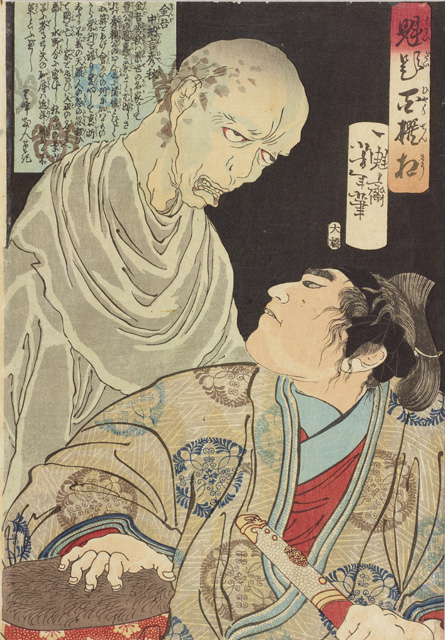
“Yoshitoshi’s Selection of One Hundred Warriors : Kingo Chūnagon Hideaki”
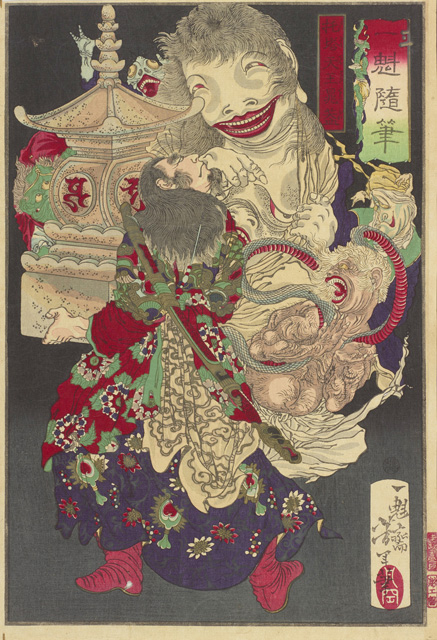
“Essays by Yoshitoshi : Takutō Tennō Chōgai”
The complete works of “One Hundred Ghost Stories of China and Japan”, a set of pictures from Yoshitoshi’s early years
“One Hundred Ghost Stories of China and Japan” was published in 1865, which was Yoshitoshi’s 27th calendar year. This was the first series of pictures depicting specters by Yoshitoshi, consisting of 26 works. The phrase “One Hundred Ghost Stories” in the title originally represented a gathering in which a group of people got together to tell scary stories, but later it came to be used as a title for a book compiling scary stories. This series of works widely collected scary stories from Japan and China, which were collectively called Wakan. As a promising ukiyo-e artist, Yoshitoshi in his younger days put a lot of effort into this book of specter pictures.
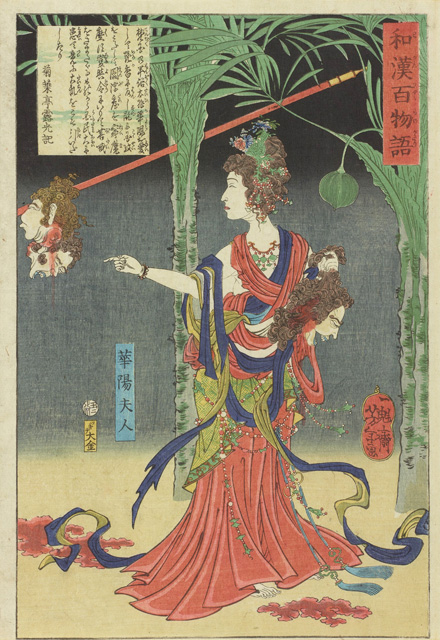
“One Hundred Ghost Stories of China and Japan : Lady Kayō”
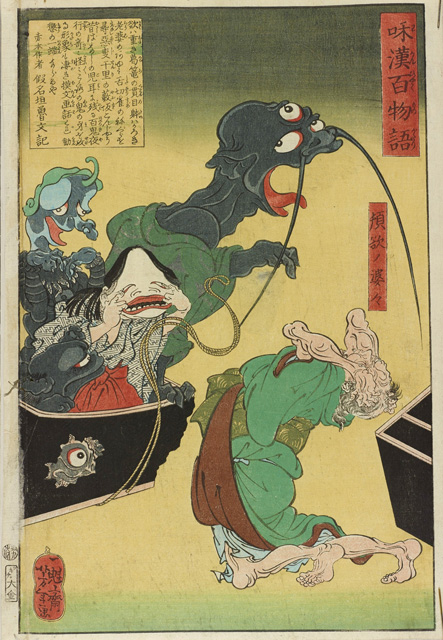
“One Hundred Ghost Stories of China and Japan : Insatiable Old Woman”
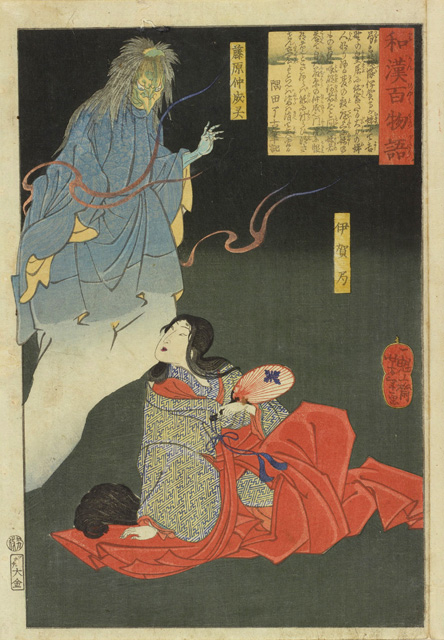
“One Hundred Ghost Stories of China and Japan : Iga-no Tsubone”
“New Forms of Thirty-six Ghosts” is a series of 36 pictures depicting specters, which was published from 1889 to 1892 in the Meiji period. Yoshitoshi was in his 51st year when its publication started, and some of the pictures were published after he died in 1892. It is literally a masterpiece of his latest years, and is also a compilation of the specter pictures which he had been working on for all those years. It is considered that the word “新形 shin-kei (new style) ” in the title is homophone of such as “神経 shin-kei (nerve) ” and “真景 shin-kei (actual scene) ” which were trendy words at the time.
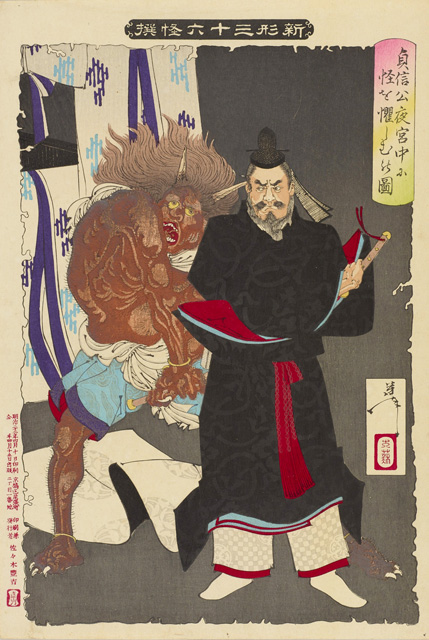
“New Forms of Thirty-six Ghosts : Lord Teishin Frightening an Ogre”
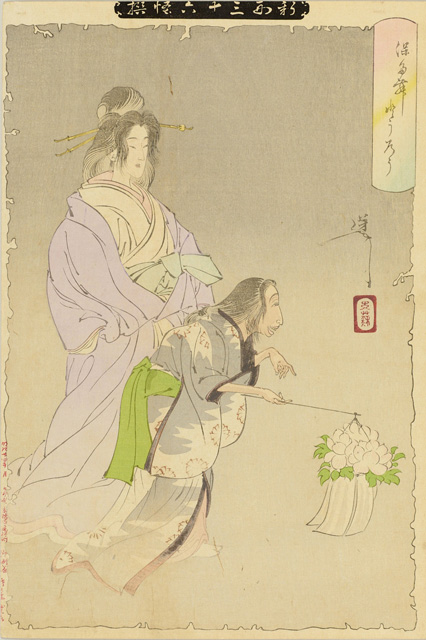
“New Forms of Thirty-six Ghosts : Female Ghost Visiting a Man”
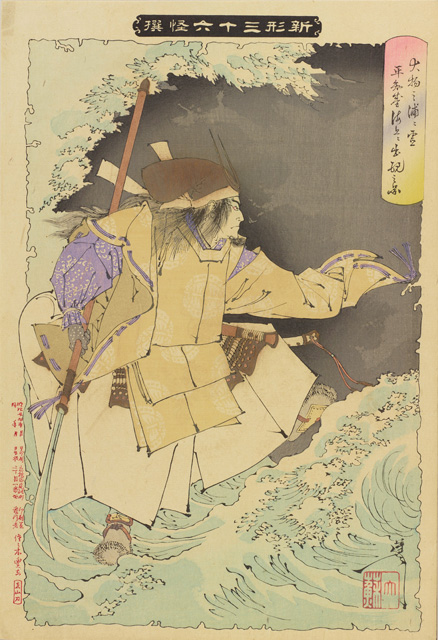
“New Forms of Thirty-six Ghosts : Ghost of Taira-no Tomomori Appearing at Daimotsu Bay”
<Highlight work of Exhibition>
“New Forms of Thirty-six Ghosts : Minamoto-no Yorimitsu Slashing at a Demon Spider”
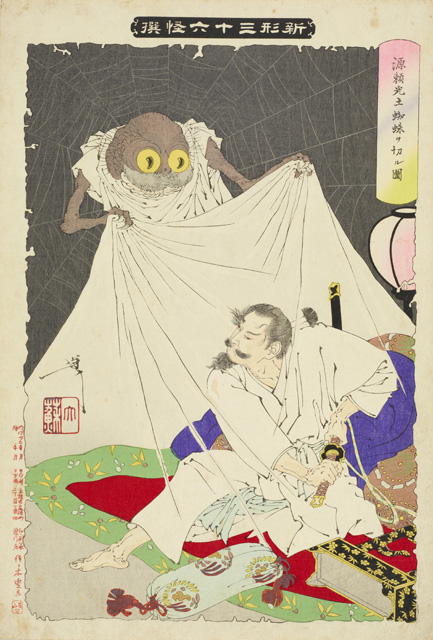
This is a picture of Minamoto-no Yorimitsu hunting Tsuchigumo, which is based on a story from Tsurugi-no Maki (Book of Swords) of Tale of the Heike and Record of the Great Peace. One night while Yorimistu, a warrior of the Heian period, was attacked by a disease and lay sick in bed, a priest appeared out of nowhere, and tried to bind him with a rope. Yorimitsu was startled but quickly responded to slash him with his legendary sword “Hizamaru” that was kept at his bedside. His followers, the four guardians who were on night duty in a different room, also rushed to help him. As they hunted down the traces of blood, they found a giant spider (Tsuchigumo), and they bravely exterminated it. Yorimitsu’s legendary sword “Hizamaru” came to be called “Kumokiri” (to slash a spider) after this incident. In this powerfully composed picture, Yoshitoshi depicted the moment of Tsuchigumo, disguised as a priest, trying to bind Yorimitsu with a semi-transparent spider’s web, while Yorimitsu is about to draw his sword “Hizamaru”. The depiction of the yellow goggling eyes of Tsuchigumo is striking.
Admission
| Adult | 1000 yen |
|---|---|
| University and High school students | 700 yen |
| Junior High School Students and below | Free |
Calendar
Closed
-
-
-
2017 July
SUN MON TUE WED THU FRI SAT 1 2 3 4 5 6 7 8 9 10 11 12 13 14 15 16 17 18 19 20 21 22 23 24 25 26 27 28 29 30 31 -
2017 AugustSpecial Exhibition
SUN MON TUE WED THU FRI SAT 1 2 3 4 5 6 7 8 9 10 11 12 13 14 15 16 17 18 19 20 21 22 23 24 25 26 27 28 29 30 31
-
-
Cruising around Edo
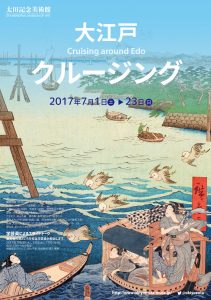
As the Tokyo 2020 Olympics approaches, there has been a growing trend to re-discover the attractiveness of the waterside of Tokyo and to consider the potential use of water transportation for tourism and as a mean of public transportation. It may be difficult to imagine now, but Edo in the old days was in fact a city of water: numerous moats and canals were built across the city, which is surrounded by the Sumida River and Edo Bay. There are a lot of ukiyo-e pictures that depict people enjoying boating on the Sumida River, and people riding on a passenger boat departing from an inn for sailors, just like riding a taxi in modern days. There are also pictures depicting boats transporting goods, which were sourced from all over Japan, into the city of Edo. Such pictures suggest that the waterside and boats played a fundamental, essential part in ordinary people’s lives. Furthermore, spending a cool evening in summer in Ryōgoku was a particularly big event in Edo. A large crowd of people used to visit this area to enjoy boating and fireworks displays, and the river was filled with numerous boats. In this exhibition, we would like to take you cruising around Edo through ukiyo-e pictures depicting various scenes of the waterside of Edo. A perfect exhibition for summer!
Cruising along the waterside of Edo
Starting from Nihonbashi, let’s cruise around the city of Edo. In this section, we will introduce pictures depicting various scenes of the waterside of Edo such as the Nihonbashi River, around Tsukudajima Island, the Sumida River, the Onagi River and Shibaura.
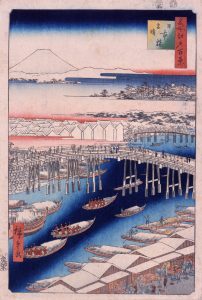
Utagawa Hiroshige “One Hundred Famous Views of Edo : Clearing Weather after Snowfall at Nihombashi”
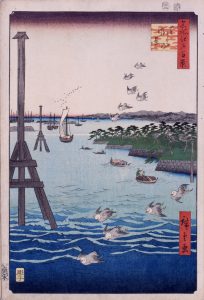
Utagawa Hiroshige “One Hundred Famous Views of Edo : View of Shibaura
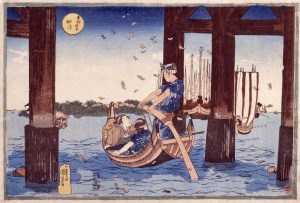
Utagawa Kuniyoshi “Famous Places in the Eastern Capital : Tsukudajima
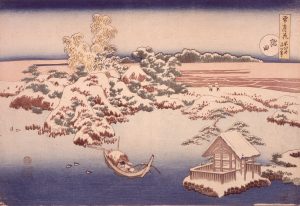
Katsushika Hokusai “Snow, Moon, and Flowers : The Sumida River
The cool breeze at the Sumida River - boating and fireworks
The Sumida River used to be officially opened on May 28th every year, which was the start of the “nōryō” (enjoying cool evenings in summer) period that lasted until August 28th. During this season, fireworks would be displayed around the Ryōgoku area, and a huge number of boats cruised on the river, carrying people enjoying boating.
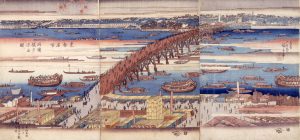
Utagawa Hiroshige “Famous Places in the Eastern Capital : Cooling off at Ryōgokubashi Bridge”
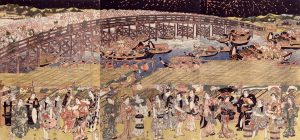
Utagawa Kuniyasu “Fireworks with Kabuki Actors at Ryōgoku”
Leaving Edo, setting off to the seas around Japan
After enjoying the waterside in Edo, let’s cruise along the waterside of other parts of Japan. In this section, we will exhibit the pictures of Enoshima Island which was a popular destination of pilgrims, and ports of various districts in Japan which prospered from the shipping business.
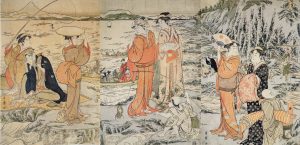
Kitagawa Utamaro “Fishing at Iwaya, Enoshima”
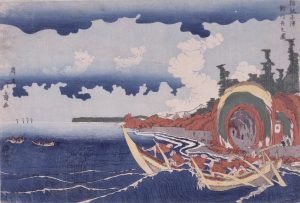
Shōtei Hokuju “Fishing-boats Hooking Bonito in the Chōshi Bay in the Province of Kazusa”
Various boats in the Edo period
In this section, we will introduce various kinds of boats and ships depicted in ukiyo-e, from pleasure boats used for boating such as “houseboats” and “food-vending boats” to the wooden sailing ships used for shipping.
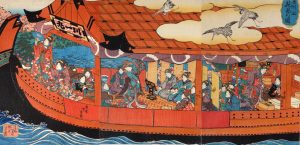
Utagawa Kunisada (Toyokuni Ⅲ)”Flower Viewing from a Pleasure Boat”
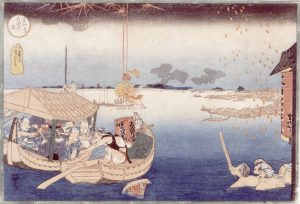
Utagawa Kuniyoshi “Famous Places in the Eastern Capital : Cooling off at Ryōgoku”
<Highlight work of Exhibition>
Utagawa Kunisada (Toyokuni Ⅲ) “Playing in Summer”
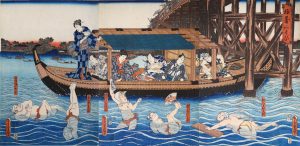
A houseboat is proceeding on the Sumida River. The bridge on the right is probably Ryōgoku Bridge, and the opposite bridge on the left of the boat is Nanba Bridge over the Yagenbori canal. This work depicts a scene in which Kabuki actors are enjoying boating on the Sumida River on a hot day in summer. Kabuki actors such as Ichikawa Danjūrō VIII and Bandō Shūka I can be seen in the boat, as well as food served on dishes. However, what draws the viewers’ attention most in this picture is the actors swimming in front of the boat. They are not only swimming but also performing funny movements such as the “flog stroke,” “mortar stroke,” “treading water,” and the “drowned-body stroke,” which are reminiscent of synchronized swimming in modern days. The actors on the boat seem to enjoy drinking and looking at their desperate swimming. In addition, it makes us feel a little sorrowful due to the fact that while the actors on the boat are young stars, the actors in the water, such as Nakayama Bungorō II and Ichikawa Hirogorō I, are supporting actors who were not of high social standing.
Admission
| Adult | 700 yen |
|---|---|
| University and High school students | 500 yen |
| Junior High School Students and below | Free |
Calendar
Closed
-
2017 July
SUN MON TUE WED THU FRI SAT 1 2 3 4 5 6 7 8 9 10 11 12 13 14 15 16 17 18 19 20 21 22 23 24 25 26 27 28 29 30 31
Warriors Based on Novels of Kyokutei Bakin
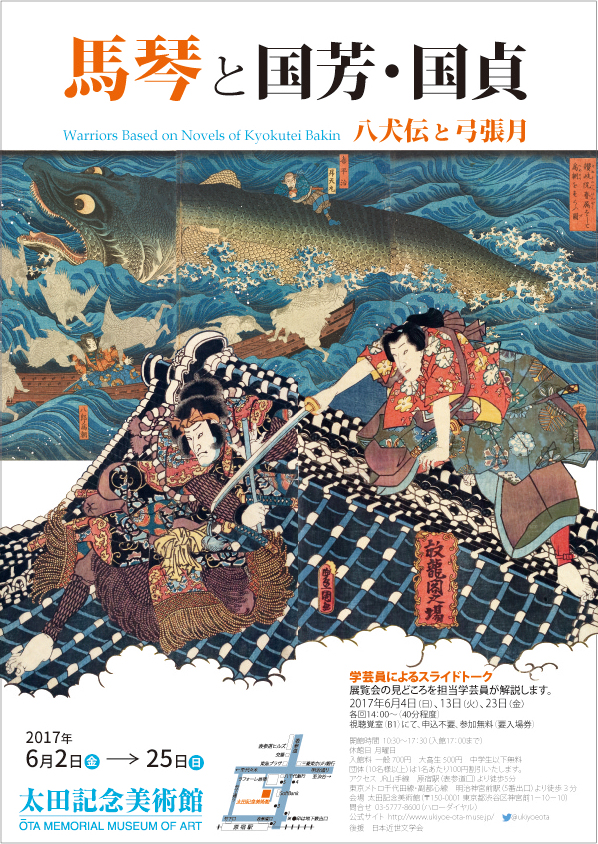
Celebrating the 250th Anniversary of the Birth of Kyokutei Bakin in 2017
Kyokutei Bakin, who is known as the author of the bestselling novel of the Edo period, Nansō Satomi Hakkenden (The Story of Eight Samurai), is still popular in the present day. His novels such as Nansō Satomi Hakkenden and Chinsetsu Yumiharizuki (The Adventure Story of Minamoto-no Tametomo) have been enjoyed not only in the original format but also in the form of kabuki performances and ukiyo-e pictures. This year, 2017, marks the 250th anniversary of the birth of Bakin. In commemoration of it, this exhibition presents 80 ukiyo-e pictures, the themes of which were taken from Bakin‘s novels.
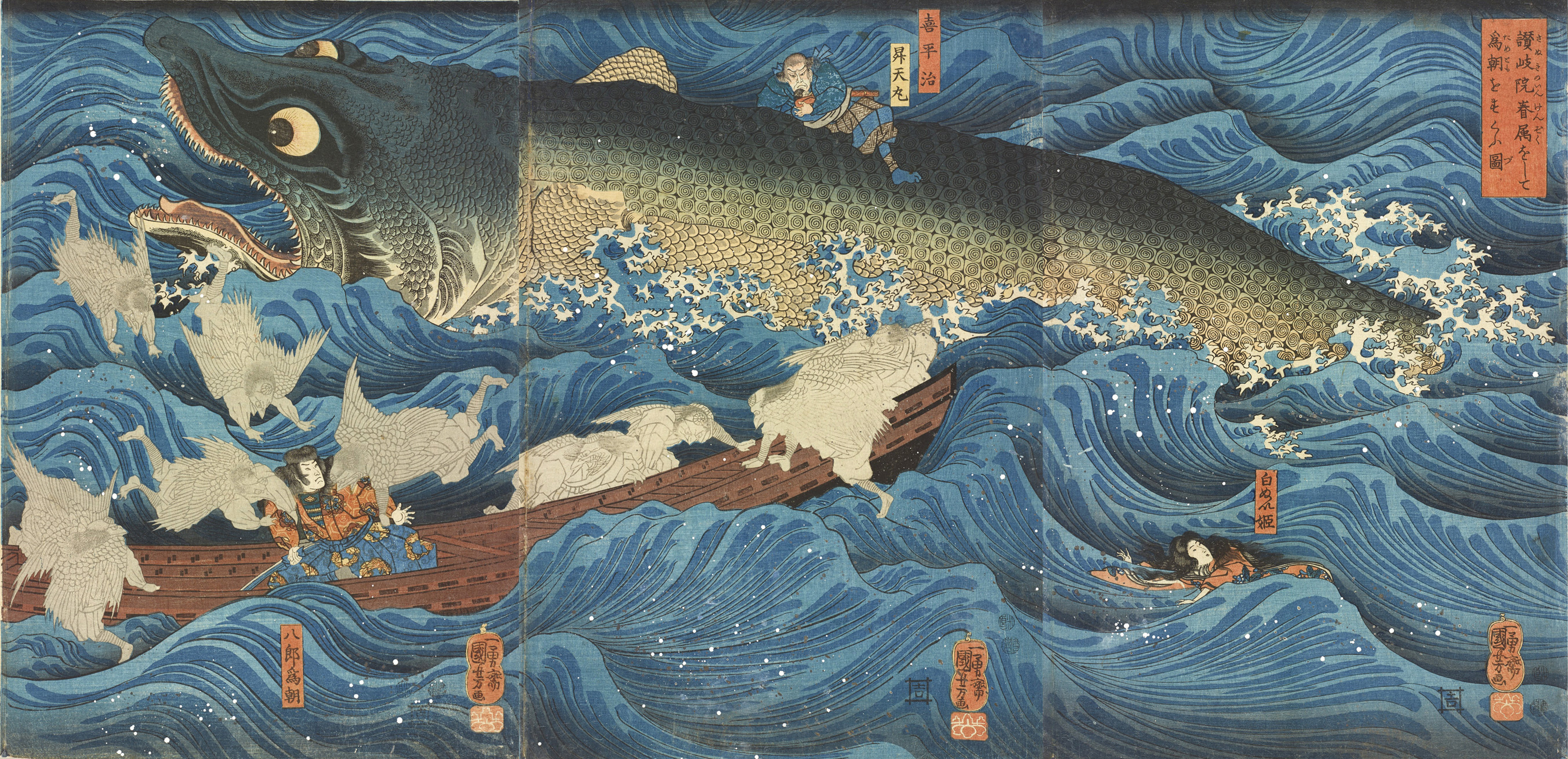
Utagawa Kuniyoshi “Minamoto-no Tametomo Rescued by Bird Long-nosed Goblins”
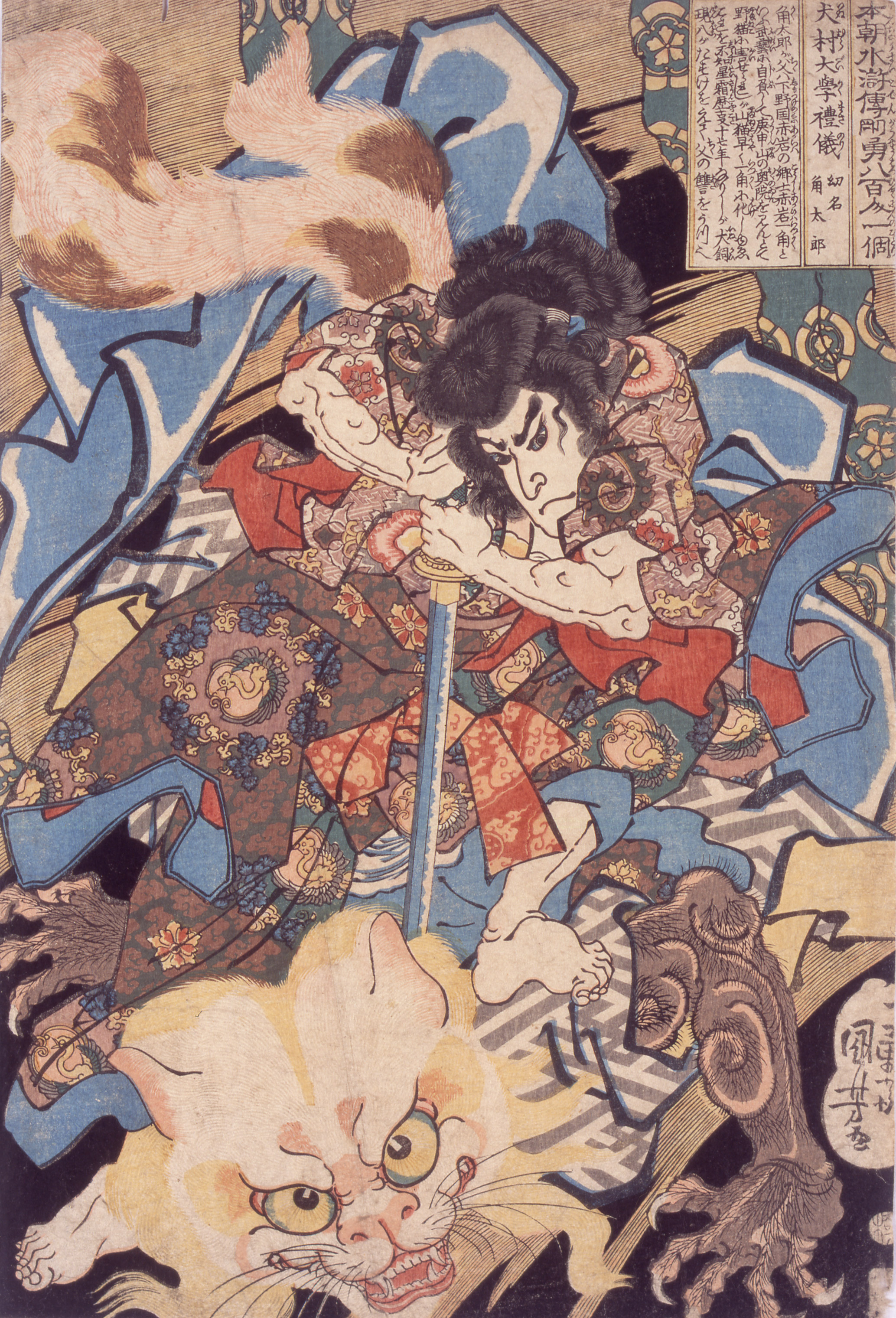
Utagawa Kuniyoshi “One of the Eight Hundred Heroes of the Water Margin of Japan : Inumura Daikaku”
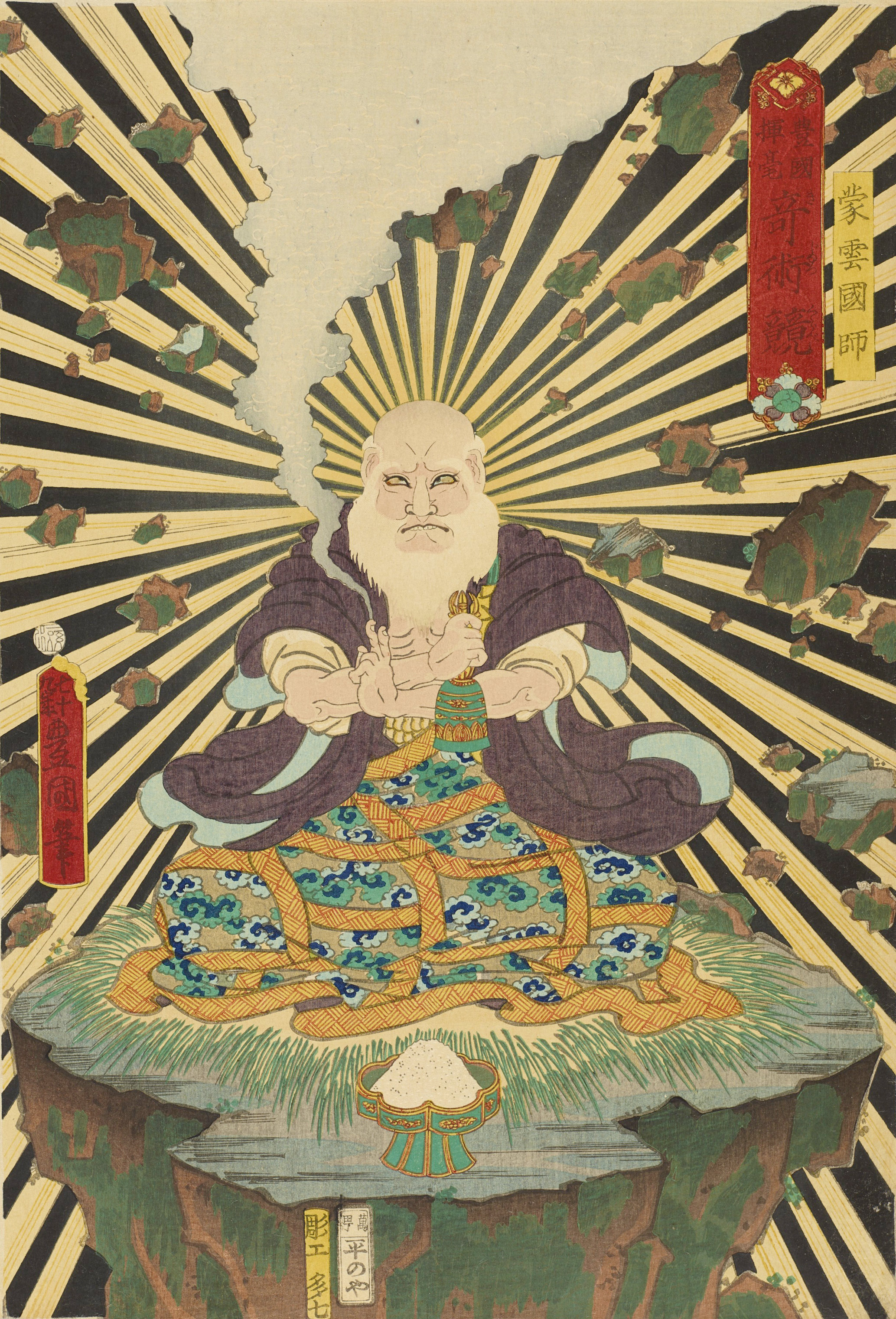
Utagawa Kunisada “Various Figures of Sorcerers : Mōun Kokushi”
Kuniyoshi vs. Kunisada: Comparison of Popular Ukiyo-e Artists
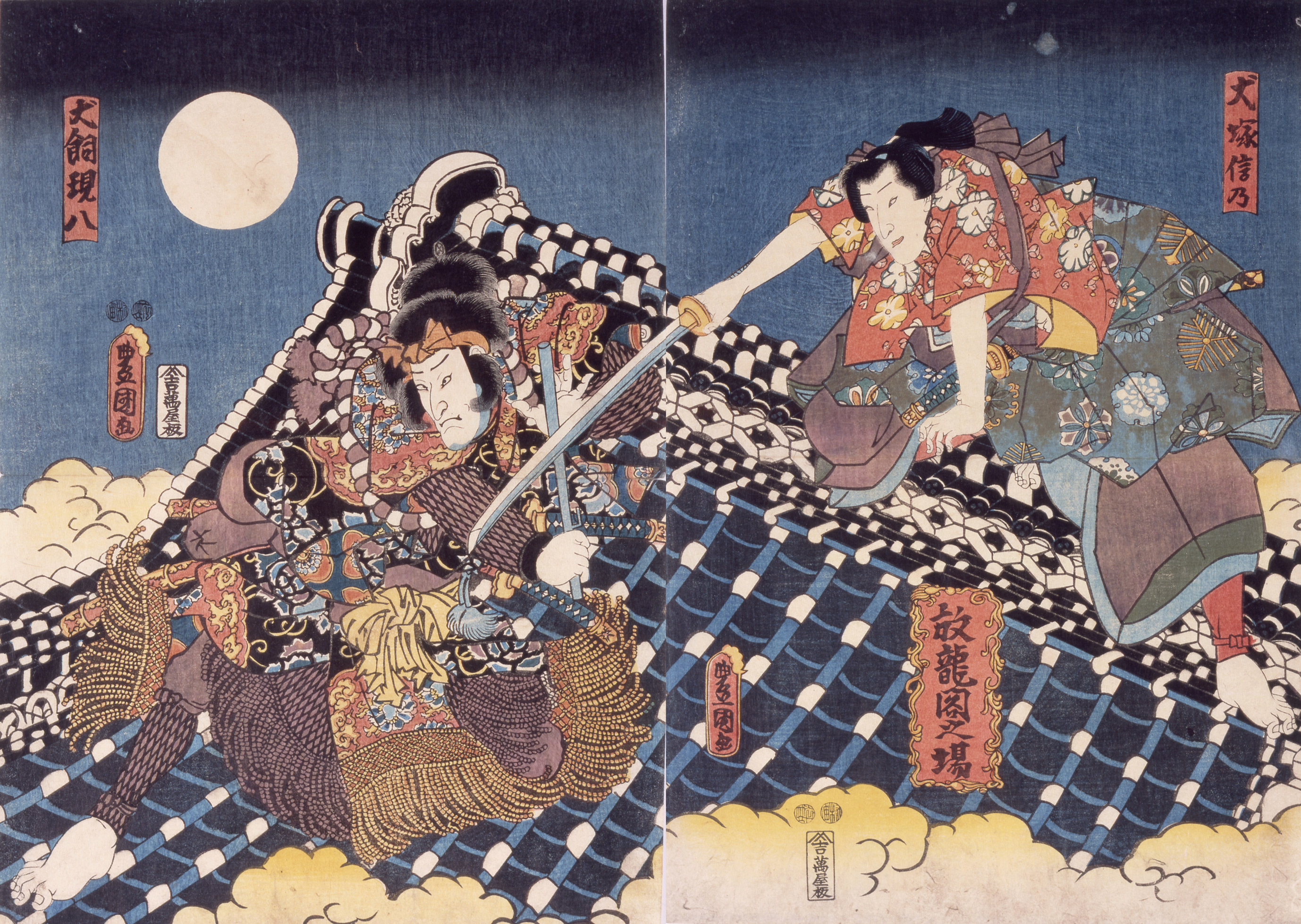
Utagawa Kunisada “Fight on the Roof of the Hōryūkaku : Inukai Genpachi / Inuzuka Shino”
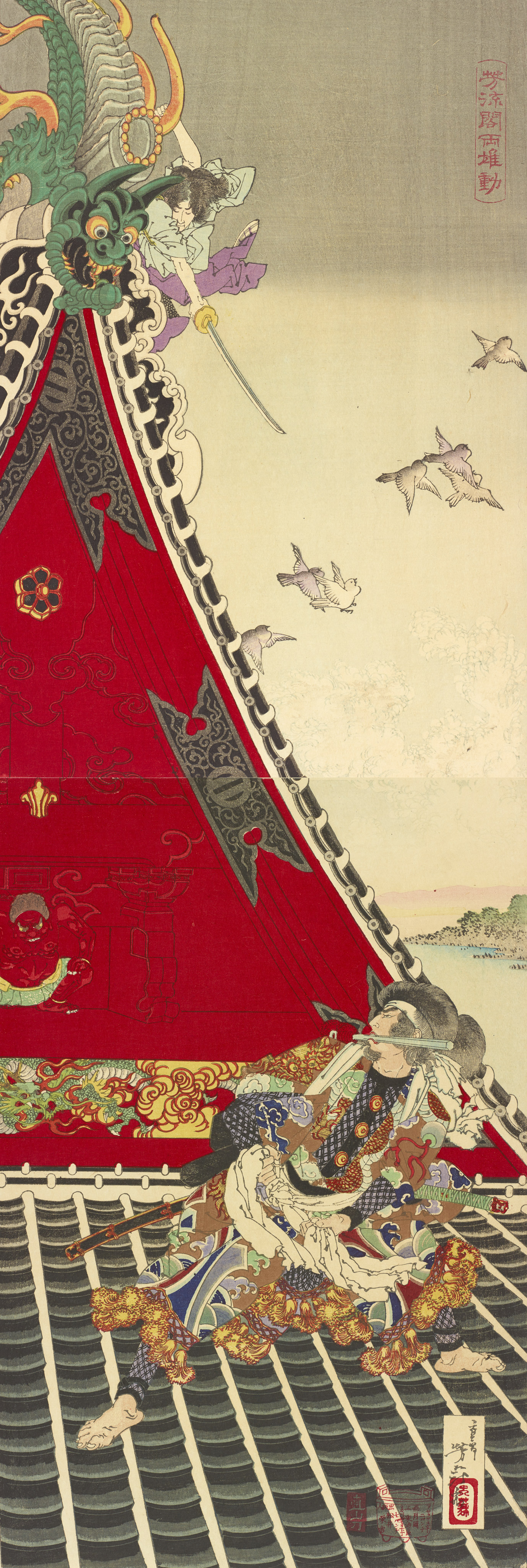
Utagawa Kuniyoshi “Fight on the Roof of the Hōryūkaku from the Hakkenden”
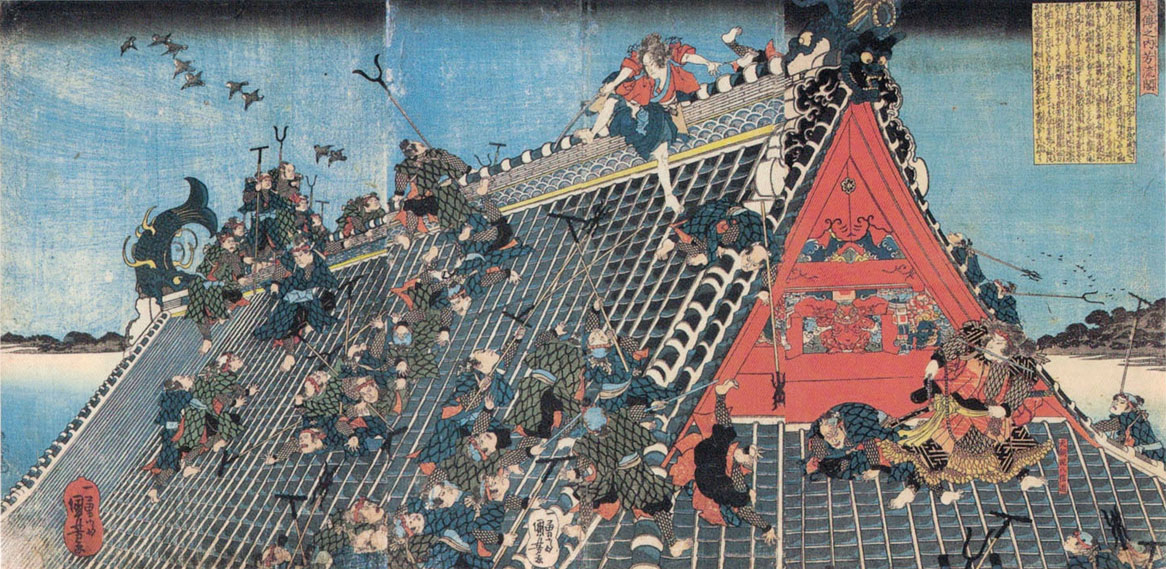
Tsukioka Yoshitoshi “Inuzuka Shino and Inukai Genpachi Battling on the Roof of Hōryūkaku”
What’s Behind the Boom of Nansō Satomi Hakkenden?
Nansō Satomi Hakkenden is one of the best and longest selling novels from the Edo period, which was written over the course of 28 years. The novel is still enjoyed in the present day in various different formats. Many people probably still remember “Shin Hakkenden (The New Story of Eight Samurai)”, a TV puppet show by NHK (Japan Broadcasting Corporation), or a 1983 feature film “Satomi Hakkenden (Legend of the Eight Samurai)” directed by Kinji Fukasaku by Kadokawa Pictures. This year the story will be performed as a kabuki play and a theatrical production, showing its strong popularity as of today. The exhibition explores the origin of the “Hakkenden boom” through ukiyo-e prints.

Utagawa Kuniyoshi “One of the Eight Hundred Heroes of the Water Margin of Japan : Inuyama Dōsetsu”
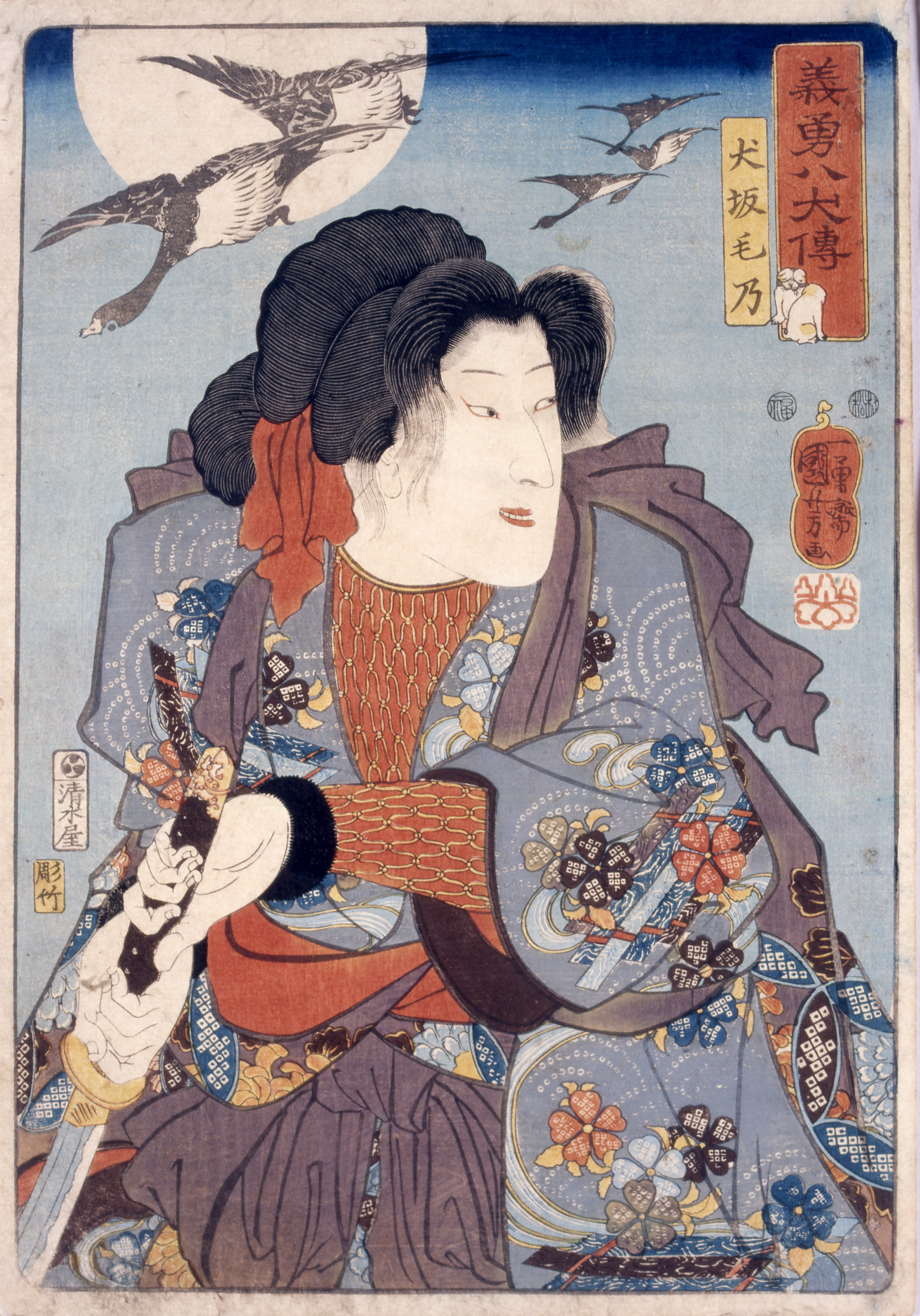
Utagawa Kuniyoshi “One of the Eight Samurai of the Hakkenden : Inuzaka Keno”
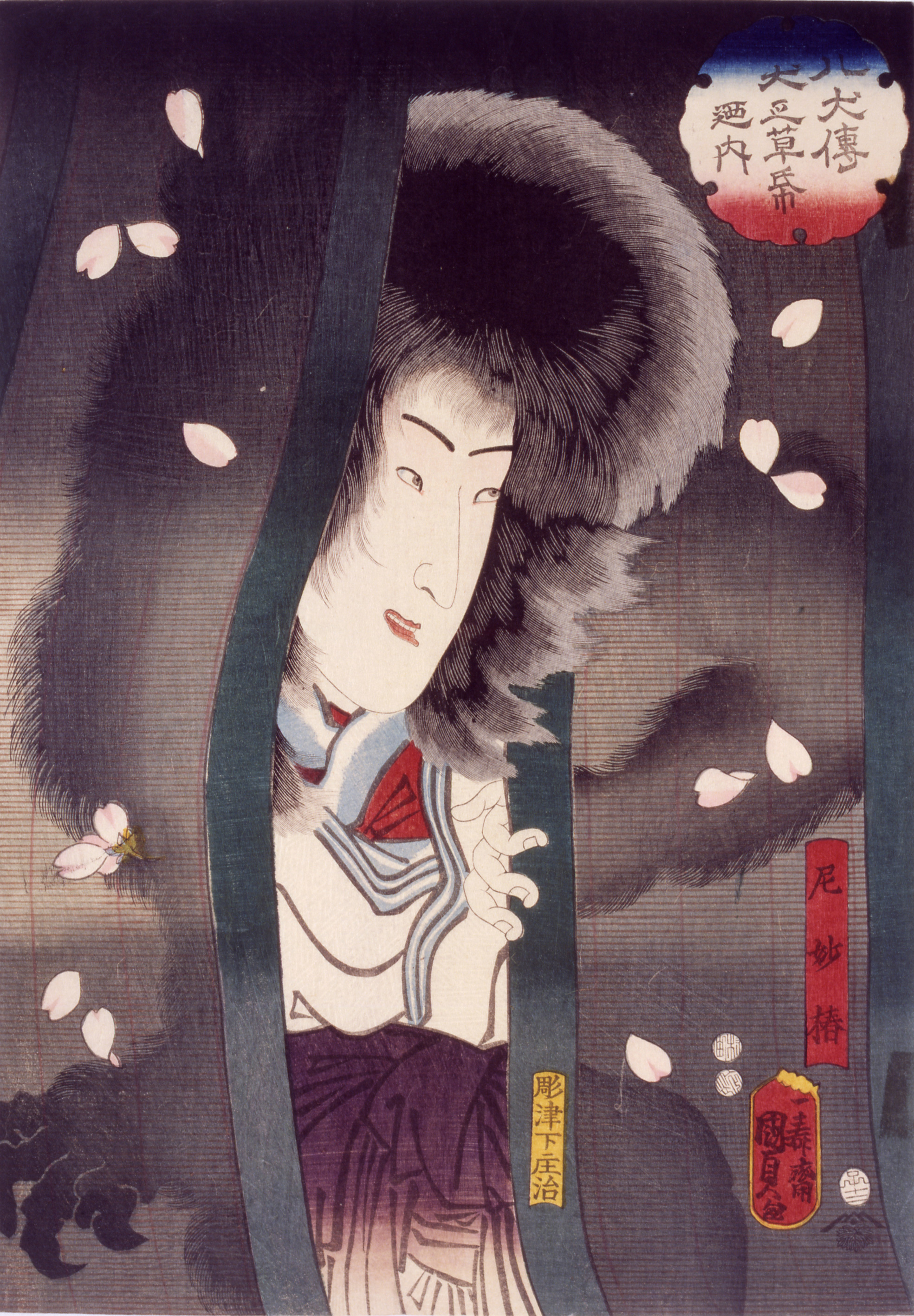
Utagawa Kunisada Ⅱ “One of the Heroes of the Hakkenden : Myōchin”
<Highlight Work of Exhibition>
Utagawa Kuniyoshi “Minamoto-no Tametomo Rescued by Bird Long-nosed Goblins”

The impressive, huge, monster-like crocodile shark is regarded as one of the best works of Kuniyoshi; however, the theme is actually based on a novel by Bakin. It is depicting a scene from Chinsetsu Yumiharizuki (The Adventure Story of Minamoto-no Tametomo), an eventful story of adventure of the protagonist Chinzei Hachiro Tametomo, who was a hero from the Heian period. Crow-billed goblins and a crocodile shark came to rescue Minamonoto-no Tametomo and his fellows who were caught up in a storm. Knowing Bakin’s stories will help people to understand and appreciate ukiyo-e prints more deeply.
Translation Supervised by Japanese Students Association of Princeton University
Admission
| Adult | 700 yen |
|---|---|
| University and High school students | 500 yen |
| Junior High School Students and below | Free |
Calendar
Closed
-
2017 June
SUN MON TUE WED THU FRI SAT 1 2 3 4 5 6 7 8 9 10 11 12 13 14 15 16 17 18 19 20 21 22 23 24 25 26 27 28 29 30
Animals in Ukiyo-e
[2nd Term] May 2nd~28th
※Works change between two terms
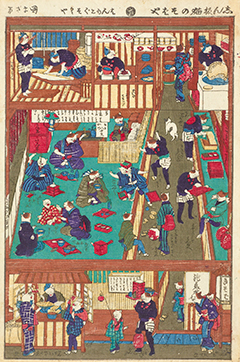
The return of “Animals in Ukiyo-e” ~From cat to dragon
From pets such as cats and goldfish to personified octopuses and foxes to mystical dragons and kappa (water sprite). The exhibition “Animals in Ukiyo-e”, which introduced various animals depicted in ukiyo-e and enjoyed popularity in 2010, has come back with an even more powerful collection. Twice as many pieces, approximately 160 in total, will be exhibited. Both those who did visited the last exhibition and those who did not are sure to find your favorite ukiyo-e animal. Please enjoy the cute animals in the museum in this season of new life.

Utagawa Kuniyoshi “Yoshiwara Sparrows’ Temporary Nest” (Exhibited in the 1st term)
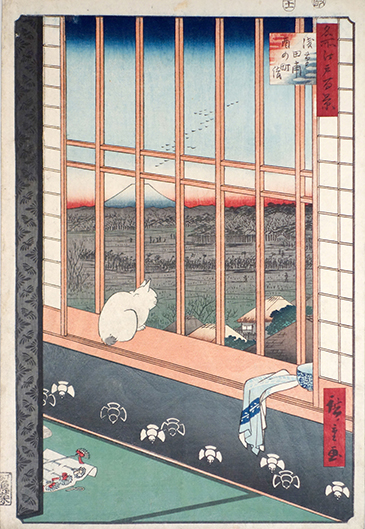
Utagawa Hiroshige “Visitors to Tori-no-machi Market at Asakusa Tambo” (Exhibited in the 2nd term)
Not only Kuniyoshi! Let’s compare the masters’ animals
When we think about animals in ukiyo-e, many people may think of the pictures of cute cats by Kuniyoshi. However Kuniyoshi was not the only one good at depicting animals. In this exhibition, works of famous artists such as Suzuki Harunobu, Katsushika Hokusai, Utagawa Hiroshige, Tsukioka Yoshitoshi and Kawanabe Kyōsai will appear. It is worth looking at how each artist characterizes his animals.
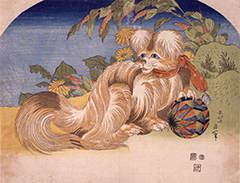
Katsushika Hokusai “Chin (Japanese spaniel)” (Exhibited in the 2nd term)
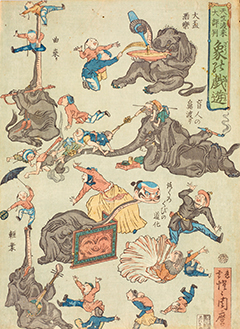
Kawanabe Kyōsai “Playing Elephants” (Exhibited in the 1st term)
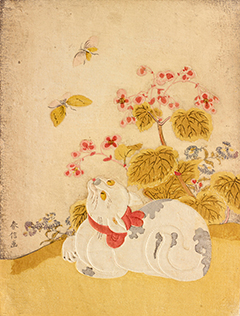
Suzuki Harunobu “Cat and Butterflies” (Exhibited in the 1st term)
Personified animals ~playing, eating, battling~
From the national treasure “Chōjū-giga” (12c~13c) to Disney movies, personified animals have been loved for a long time. In ukiyo-e, octopuses dance, birds show performances, and cats enjoy eating Japanese noodles. Others are very busy fighting or taking Sumō wrestling. It is one of the highlights of this exhibition to see the figures of familiar animals acting just like the people of Edo.
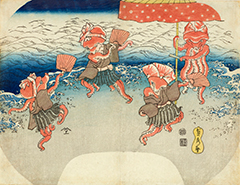
Utagawa Sadahide “Octopus Dance” (Exhibited in the 2nd term)
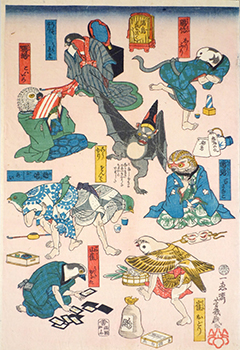
Ochiai Yoshiiku “Performances of Birds” (Exhibited in the 1st term)

Utagawa Kunimasa Ⅳ “Cats in Buckwheat-noodle Restaurant” (Exhibited in the 2nd term)
Strange animals
Like the “Twelve Animals of the Zodiac Fused to Form one Animal”, imaginary animals were often the subject of ukiyo-e paintings. On the other hand, pictures depicting elephants and leopards, which were imported from overseas for shows, garnered popularity as well. Some pictures depict rare creatures in detail like illustrations from encyclopedias. Artists fully used their imaginations and obserant eye to depict the strangest of animals.
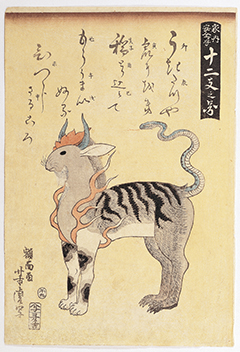
Utagawa Yoshitora “Twelve Animals of the Zodiac Fused to Form one Animal” (Exhibited in the 2nd term)
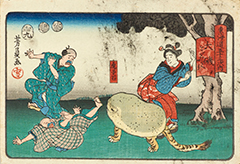
Utagawa Yoshikazu “Fifty-three Stations of the Tokaido Road : Oiso” (Exhibited in the 1st term)
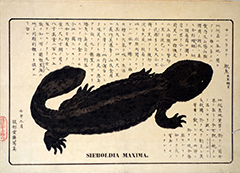
Hattori Sessai “Salamander” (Exhibited in the 2nd term)
Animals in everyday life
In the Edo period, people used the Zodiac to express the dates, time and directions, and used cows and horses as a crucial working force. Many kinds of animals besides pets blended well into human’s daily life. Some of them can even be seen in patterns of Kimono. These works shows us the fact that the relationship between humans and animals were much closer than today.
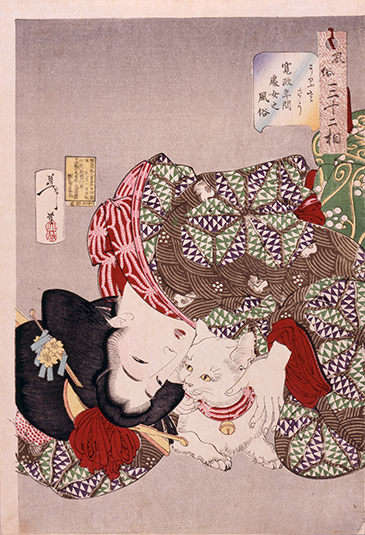
Thirty-two Aspects of Women : Looking Troublesome, Mannerisms of a Girl of the Kansei Period (Exhibited in the 1st term)
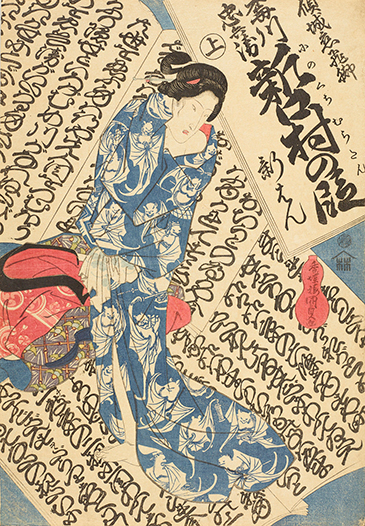
Utagawa Kunisada “Beautiful Woman Depicted against the Background of Practice Books for Ballad Drama” (Exhibited in the 2nd term)
<Highlight Work of Exhibition>
Utagawa Yoshitoyo “Great Elephant Born in Malacca”
(Exhibited in the 1st term)
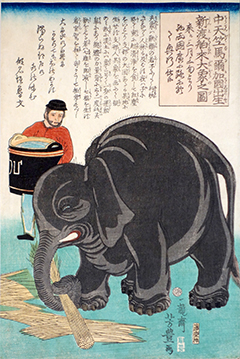
The elephants the star of the zoo, liked by everyone from children to adults. However, in the Edo period, it was one of the strangest animals that people could never find in Japan. The elephant in this picture came to Yokohama from Malacca on an American ship in 1862, and this picture was created at its showing in Ryōgoku the following year. Surprisingly, this elephant went on a provincial tour all over Japan that took more than 10 years. Although its charming figure skillfully using its long nose is familiar to us today, the sentence in the picture tells us that it was publicized as a fortunate animal that brought good luck to those who set eyes on it. We can feel how differently the people of Edo conceived elephants compared to people of today.
Translation Supervised by Japanese Students Association of Princeton University
Admission
| Adult | 700 yen |
|---|---|
| University and High school students | 500 yen |
| Junior High School Students and below | Free |
Calendar
Closed
-
2017 April
SUN MON TUE WED THU FRI SAT 1 2 3 4 5 6 7 8 9 10 12 12 13 14 15 16 17 18 19 20 21 22 23 24 25 26 27 28 29 30 -
2017 May
SUN MON TUE WED THU FRI SAT 1 2 3 4 5 6 7 8 9 10 11 12 13 14 15 16 17 18 19 20 21 22 23 24 25 26 27 28 29 30 31
